Functional Anatomy Assignment: Posture, Injuries, Joint Complexes, Muscles, and Agility
VerifiedAdded on 2023/06/12
|20
|7445
|378
AI Summary
This assignment covers topics such as posture, injuries, joint complexes, muscles, and agility in functional anatomy. It includes short answer questions, tables, and explanations of various factors that affect coordination and agility.
Contribute Materials
Your contribution can guide someone’s learning journey. Share your
documents today.
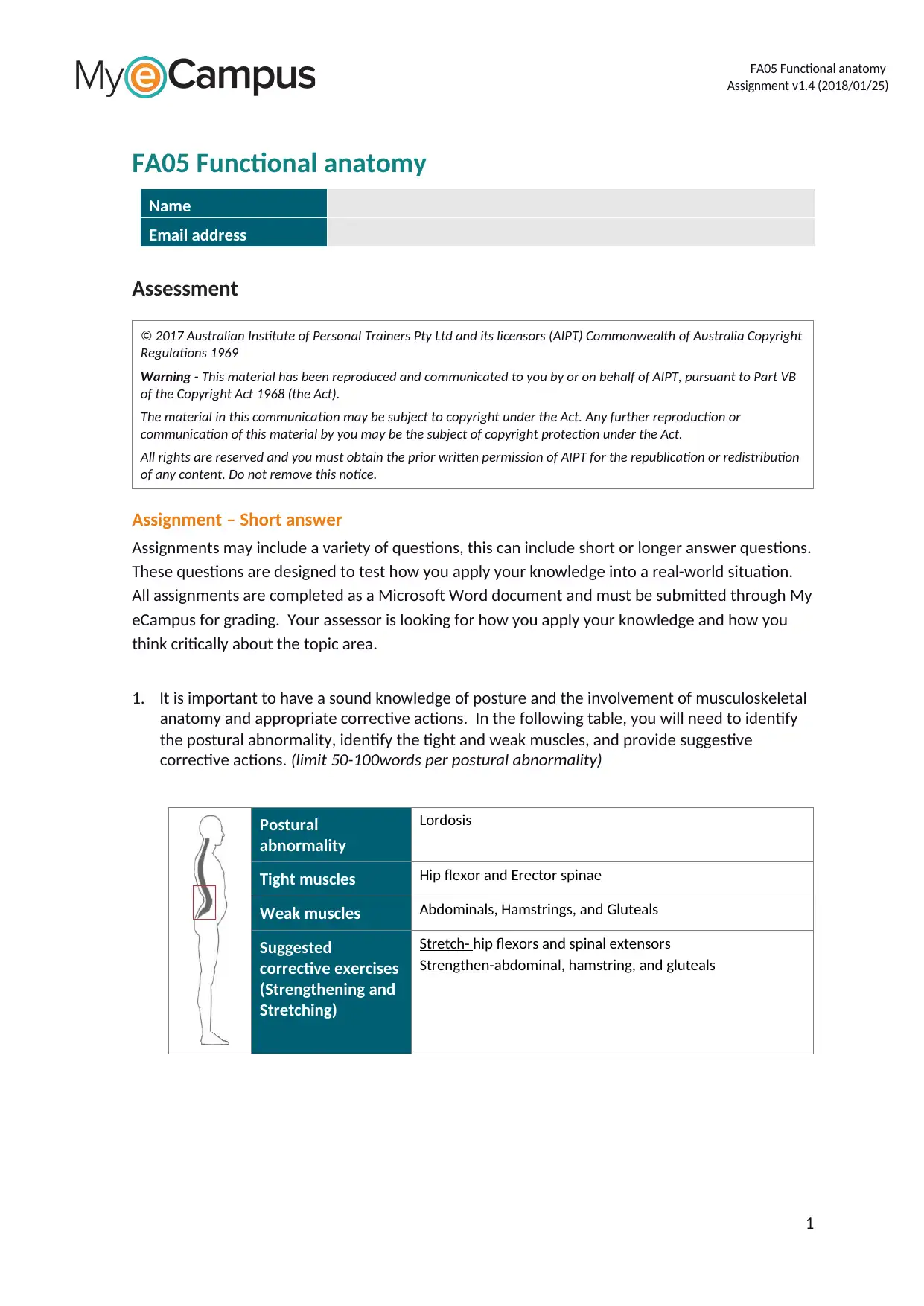
FA05 Functional anatomy
Assignment v1.4 (2018/01/25)
FA05 Functional anatomy
Name
Email address
Assessment
© 2017 Australian Institute of Personal Trainers Pty Ltd and its licensors (AIPT) Commonwealth of Australia Copyright
Regulations 1969
Warning - This material has been reproduced and communicated to you by or on behalf of AIPT, pursuant to Part VB
of the Copyright Act 1968 (the Act).
The material in this communication may be subject to copyright under the Act. Any further reproduction or
communication of this material by you may be the subject of copyright protection under the Act.
All rights are reserved and you must obtain the prior written permission of AIPT for the republication or redistribution
of any content. Do not remove this notice.
Assignment – Short answer
Assignments may include a variety of questions, this can include short or longer answer questions.
These questions are designed to test how you apply your knowledge into a real-world situation.
All assignments are completed as a Microsoft Word document and must be submitted through My
eCampus for grading. Your assessor is looking for how you apply your knowledge and how you
think critically about the topic area.
1. It is important to have a sound knowledge of posture and the involvement of musculoskeletal
anatomy and appropriate corrective actions. In the following table, you will need to identify
the postural abnormality, identify the tight and weak muscles, and provide suggestive
corrective actions. (limit 50-100words per postural abnormality)
Postural
abnormality
Lordosis
Tight muscles Hip flexor and Erector spinae
Weak muscles Abdominals, Hamstrings, and Gluteals
Suggested
corrective exercises
(Strengthening and
Stretching)
Stretch- hip flexors and spinal extensors
Strengthen-abdominal, hamstring, and gluteals
1
Assignment v1.4 (2018/01/25)
FA05 Functional anatomy
Name
Email address
Assessment
© 2017 Australian Institute of Personal Trainers Pty Ltd and its licensors (AIPT) Commonwealth of Australia Copyright
Regulations 1969
Warning - This material has been reproduced and communicated to you by or on behalf of AIPT, pursuant to Part VB
of the Copyright Act 1968 (the Act).
The material in this communication may be subject to copyright under the Act. Any further reproduction or
communication of this material by you may be the subject of copyright protection under the Act.
All rights are reserved and you must obtain the prior written permission of AIPT for the republication or redistribution
of any content. Do not remove this notice.
Assignment – Short answer
Assignments may include a variety of questions, this can include short or longer answer questions.
These questions are designed to test how you apply your knowledge into a real-world situation.
All assignments are completed as a Microsoft Word document and must be submitted through My
eCampus for grading. Your assessor is looking for how you apply your knowledge and how you
think critically about the topic area.
1. It is important to have a sound knowledge of posture and the involvement of musculoskeletal
anatomy and appropriate corrective actions. In the following table, you will need to identify
the postural abnormality, identify the tight and weak muscles, and provide suggestive
corrective actions. (limit 50-100words per postural abnormality)
Postural
abnormality
Lordosis
Tight muscles Hip flexor and Erector spinae
Weak muscles Abdominals, Hamstrings, and Gluteals
Suggested
corrective exercises
(Strengthening and
Stretching)
Stretch- hip flexors and spinal extensors
Strengthen-abdominal, hamstring, and gluteals
1
Secure Best Marks with AI Grader
Need help grading? Try our AI Grader for instant feedback on your assignments.
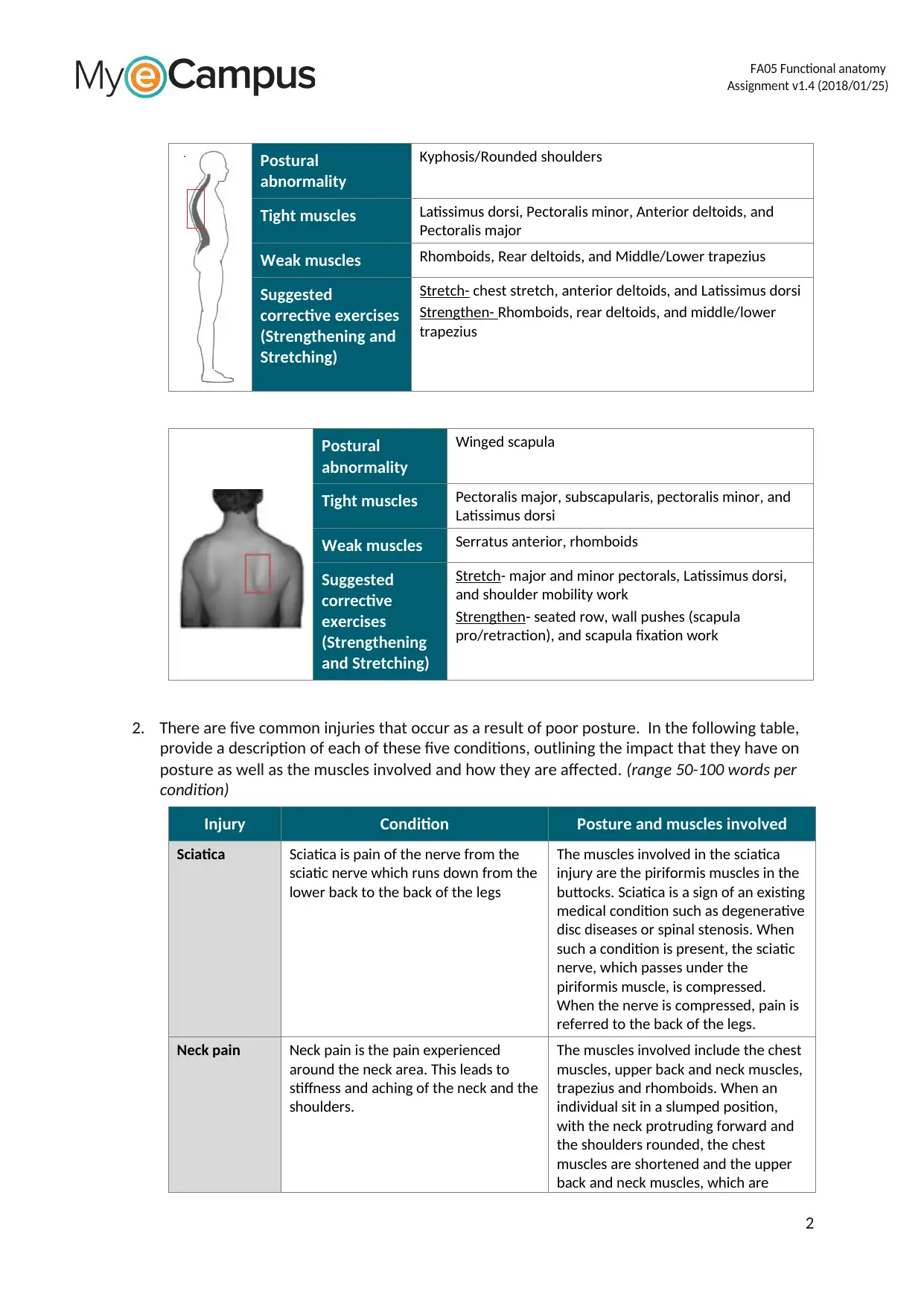
FA05 Functional anatomy
Assignment v1.4 (2018/01/25)
Postural
abnormality
Kyphosis/Rounded shoulders
Tight muscles Latissimus dorsi, Pectoralis minor, Anterior deltoids, and
Pectoralis major
Weak muscles Rhomboids, Rear deltoids, and Middle/Lower trapezius
Suggested
corrective exercises
(Strengthening and
Stretching)
Stretch- chest stretch, anterior deltoids, and Latissimus dorsi
Strengthen- Rhomboids, rear deltoids, and middle/lower
trapezius
Postural
abnormality
Winged scapula
Tight muscles Pectoralis major, subscapularis, pectoralis minor, and
Latissimus dorsi
Weak muscles Serratus anterior, rhomboids
Suggested
corrective
exercises
(Strengthening
and Stretching)
Stretch- major and minor pectorals, Latissimus dorsi,
and shoulder mobility work
Strengthen- seated row, wall pushes (scapula
pro/retraction), and scapula fixation work
2. There are five common injuries that occur as a result of poor posture. In the following table,
provide a description of each of these five conditions, outlining the impact that they have on
posture as well as the muscles involved and how they are affected. (range 50-100 words per
condition)
Injury Condition Posture and muscles involved
Sciatica Sciatica is pain of the nerve from the
sciatic nerve which runs down from the
lower back to the back of the legs
The muscles involved in the sciatica
injury are the piriformis muscles in the
buttocks. Sciatica is a sign of an existing
medical condition such as degenerative
disc diseases or spinal stenosis. When
such a condition is present, the sciatic
nerve, which passes under the
piriformis muscle, is compressed.
When the nerve is compressed, pain is
referred to the back of the legs.
Neck pain Neck pain is the pain experienced
around the neck area. This leads to
stiffness and aching of the neck and the
shoulders.
The muscles involved include the chest
muscles, upper back and neck muscles,
trapezius and rhomboids. When an
individual sit in a slumped position,
with the neck protruding forward and
the shoulders rounded, the chest
muscles are shortened and the upper
back and neck muscles, which are
2
Assignment v1.4 (2018/01/25)
Postural
abnormality
Kyphosis/Rounded shoulders
Tight muscles Latissimus dorsi, Pectoralis minor, Anterior deltoids, and
Pectoralis major
Weak muscles Rhomboids, Rear deltoids, and Middle/Lower trapezius
Suggested
corrective exercises
(Strengthening and
Stretching)
Stretch- chest stretch, anterior deltoids, and Latissimus dorsi
Strengthen- Rhomboids, rear deltoids, and middle/lower
trapezius
Postural
abnormality
Winged scapula
Tight muscles Pectoralis major, subscapularis, pectoralis minor, and
Latissimus dorsi
Weak muscles Serratus anterior, rhomboids
Suggested
corrective
exercises
(Strengthening
and Stretching)
Stretch- major and minor pectorals, Latissimus dorsi,
and shoulder mobility work
Strengthen- seated row, wall pushes (scapula
pro/retraction), and scapula fixation work
2. There are five common injuries that occur as a result of poor posture. In the following table,
provide a description of each of these five conditions, outlining the impact that they have on
posture as well as the muscles involved and how they are affected. (range 50-100 words per
condition)
Injury Condition Posture and muscles involved
Sciatica Sciatica is pain of the nerve from the
sciatic nerve which runs down from the
lower back to the back of the legs
The muscles involved in the sciatica
injury are the piriformis muscles in the
buttocks. Sciatica is a sign of an existing
medical condition such as degenerative
disc diseases or spinal stenosis. When
such a condition is present, the sciatic
nerve, which passes under the
piriformis muscle, is compressed.
When the nerve is compressed, pain is
referred to the back of the legs.
Neck pain Neck pain is the pain experienced
around the neck area. This leads to
stiffness and aching of the neck and the
shoulders.
The muscles involved include the chest
muscles, upper back and neck muscles,
trapezius and rhomboids. When an
individual sit in a slumped position,
with the neck protruding forward and
the shoulders rounded, the chest
muscles are shortened and the upper
back and neck muscles, which are
2
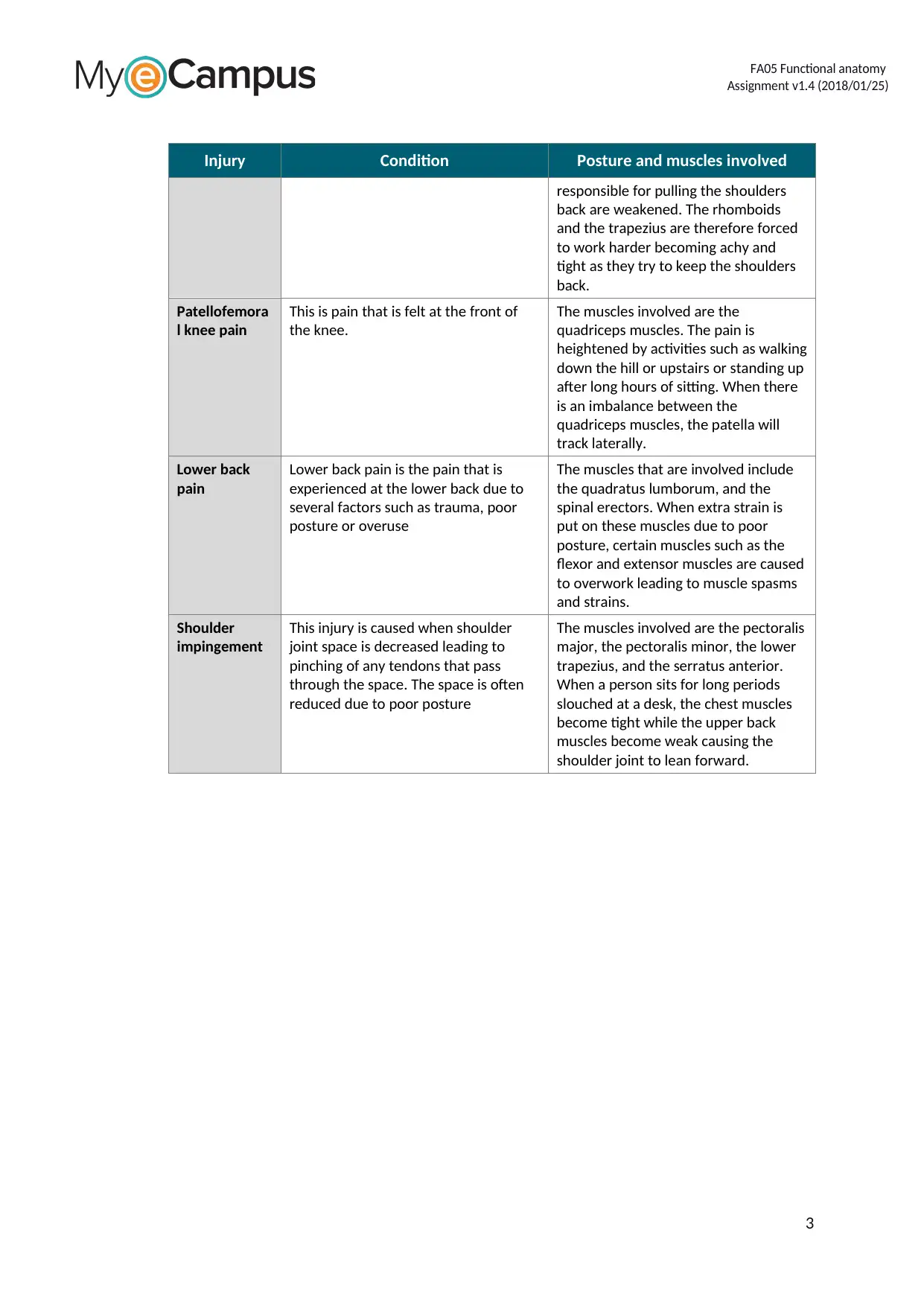
FA05 Functional anatomy
Assignment v1.4 (2018/01/25)
Injury Condition Posture and muscles involved
responsible for pulling the shoulders
back are weakened. The rhomboids
and the trapezius are therefore forced
to work harder becoming achy and
tight as they try to keep the shoulders
back.
Patellofemora
l knee pain
This is pain that is felt at the front of
the knee.
The muscles involved are the
quadriceps muscles. The pain is
heightened by activities such as walking
down the hill or upstairs or standing up
after long hours of sitting. When there
is an imbalance between the
quadriceps muscles, the patella will
track laterally.
Lower back
pain
Lower back pain is the pain that is
experienced at the lower back due to
several factors such as trauma, poor
posture or overuse
The muscles that are involved include
the quadratus lumborum, and the
spinal erectors. When extra strain is
put on these muscles due to poor
posture, certain muscles such as the
flexor and extensor muscles are caused
to overwork leading to muscle spasms
and strains.
Shoulder
impingement
This injury is caused when shoulder
joint space is decreased leading to
pinching of any tendons that pass
through the space. The space is often
reduced due to poor posture
The muscles involved are the pectoralis
major, the pectoralis minor, the lower
trapezius, and the serratus anterior.
When a person sits for long periods
slouched at a desk, the chest muscles
become tight while the upper back
muscles become weak causing the
shoulder joint to lean forward.
3
Assignment v1.4 (2018/01/25)
Injury Condition Posture and muscles involved
responsible for pulling the shoulders
back are weakened. The rhomboids
and the trapezius are therefore forced
to work harder becoming achy and
tight as they try to keep the shoulders
back.
Patellofemora
l knee pain
This is pain that is felt at the front of
the knee.
The muscles involved are the
quadriceps muscles. The pain is
heightened by activities such as walking
down the hill or upstairs or standing up
after long hours of sitting. When there
is an imbalance between the
quadriceps muscles, the patella will
track laterally.
Lower back
pain
Lower back pain is the pain that is
experienced at the lower back due to
several factors such as trauma, poor
posture or overuse
The muscles that are involved include
the quadratus lumborum, and the
spinal erectors. When extra strain is
put on these muscles due to poor
posture, certain muscles such as the
flexor and extensor muscles are caused
to overwork leading to muscle spasms
and strains.
Shoulder
impingement
This injury is caused when shoulder
joint space is decreased leading to
pinching of any tendons that pass
through the space. The space is often
reduced due to poor posture
The muscles involved are the pectoralis
major, the pectoralis minor, the lower
trapezius, and the serratus anterior.
When a person sits for long periods
slouched at a desk, the chest muscles
become tight while the upper back
muscles become weak causing the
shoulder joint to lean forward.
3
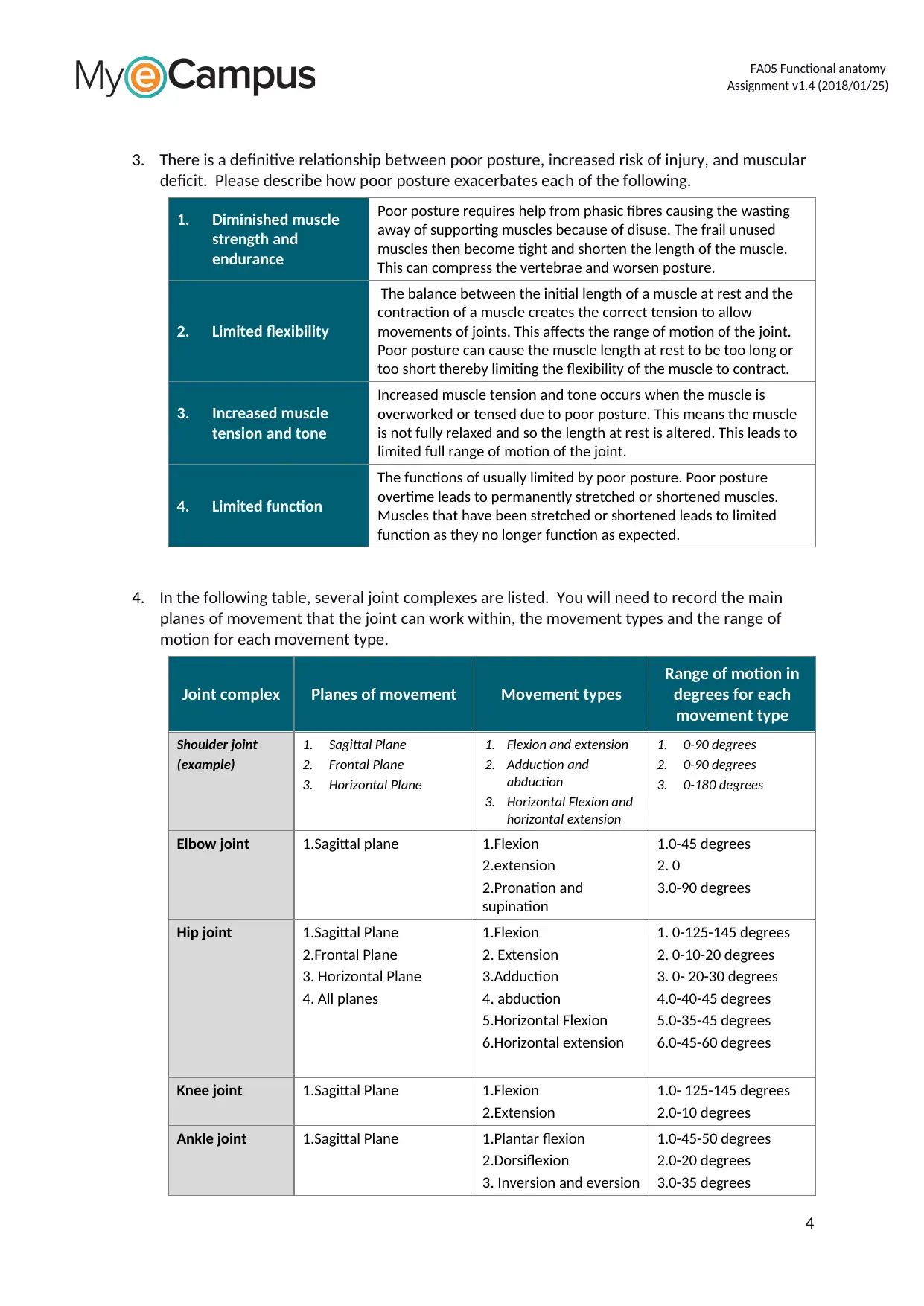
FA05 Functional anatomy
Assignment v1.4 (2018/01/25)
3. There is a definitive relationship between poor posture, increased risk of injury, and muscular
deficit. Please describe how poor posture exacerbates each of the following.
1. Diminished muscle
strength and
endurance
Poor posture requires help from phasic fibres causing the wasting
away of supporting muscles because of disuse. The frail unused
muscles then become tight and shorten the length of the muscle.
This can compress the vertebrae and worsen posture.
2. Limited flexibility
The balance between the initial length of a muscle at rest and the
contraction of a muscle creates the correct tension to allow
movements of joints. This affects the range of motion of the joint.
Poor posture can cause the muscle length at rest to be too long or
too short thereby limiting the flexibility of the muscle to contract.
3. Increased muscle
tension and tone
Increased muscle tension and tone occurs when the muscle is
overworked or tensed due to poor posture. This means the muscle
is not fully relaxed and so the length at rest is altered. This leads to
limited full range of motion of the joint.
4. Limited function
The functions of usually limited by poor posture. Poor posture
overtime leads to permanently stretched or shortened muscles.
Muscles that have been stretched or shortened leads to limited
function as they no longer function as expected.
4. In the following table, several joint complexes are listed. You will need to record the main
planes of movement that the joint can work within, the movement types and the range of
motion for each movement type.
Joint complex Planes of movement Movement types
Range of motion in
degrees for each
movement type
Shoulder joint
(example)
1. Sagittal Plane
2. Frontal Plane
3. Horizontal Plane
1. Flexion and extension
2. Adduction and
abduction
3. Horizontal Flexion and
horizontal extension
1. 0-90 degrees
2. 0-90 degrees
3. 0-180 degrees
Elbow joint 1.Sagittal plane 1.Flexion
2.extension
2.Pronation and
supination
1.0-45 degrees
2. 0
3.0-90 degrees
Hip joint 1.Sagittal Plane
2.Frontal Plane
3. Horizontal Plane
4. All planes
1.Flexion
2. Extension
3.Adduction
4. abduction
5.Horizontal Flexion
6.Horizontal extension
1. 0-125-145 degrees
2. 0-10-20 degrees
3. 0- 20-30 degrees
4.0-40-45 degrees
5.0-35-45 degrees
6.0-45-60 degrees
Knee joint 1.Sagittal Plane 1.Flexion
2.Extension
1.0- 125-145 degrees
2.0-10 degrees
Ankle joint 1.Sagittal Plane 1.Plantar flexion
2.Dorsiflexion
3. Inversion and eversion
1.0-45-50 degrees
2.0-20 degrees
3.0-35 degrees
4
Assignment v1.4 (2018/01/25)
3. There is a definitive relationship between poor posture, increased risk of injury, and muscular
deficit. Please describe how poor posture exacerbates each of the following.
1. Diminished muscle
strength and
endurance
Poor posture requires help from phasic fibres causing the wasting
away of supporting muscles because of disuse. The frail unused
muscles then become tight and shorten the length of the muscle.
This can compress the vertebrae and worsen posture.
2. Limited flexibility
The balance between the initial length of a muscle at rest and the
contraction of a muscle creates the correct tension to allow
movements of joints. This affects the range of motion of the joint.
Poor posture can cause the muscle length at rest to be too long or
too short thereby limiting the flexibility of the muscle to contract.
3. Increased muscle
tension and tone
Increased muscle tension and tone occurs when the muscle is
overworked or tensed due to poor posture. This means the muscle
is not fully relaxed and so the length at rest is altered. This leads to
limited full range of motion of the joint.
4. Limited function
The functions of usually limited by poor posture. Poor posture
overtime leads to permanently stretched or shortened muscles.
Muscles that have been stretched or shortened leads to limited
function as they no longer function as expected.
4. In the following table, several joint complexes are listed. You will need to record the main
planes of movement that the joint can work within, the movement types and the range of
motion for each movement type.
Joint complex Planes of movement Movement types
Range of motion in
degrees for each
movement type
Shoulder joint
(example)
1. Sagittal Plane
2. Frontal Plane
3. Horizontal Plane
1. Flexion and extension
2. Adduction and
abduction
3. Horizontal Flexion and
horizontal extension
1. 0-90 degrees
2. 0-90 degrees
3. 0-180 degrees
Elbow joint 1.Sagittal plane 1.Flexion
2.extension
2.Pronation and
supination
1.0-45 degrees
2. 0
3.0-90 degrees
Hip joint 1.Sagittal Plane
2.Frontal Plane
3. Horizontal Plane
4. All planes
1.Flexion
2. Extension
3.Adduction
4. abduction
5.Horizontal Flexion
6.Horizontal extension
1. 0-125-145 degrees
2. 0-10-20 degrees
3. 0- 20-30 degrees
4.0-40-45 degrees
5.0-35-45 degrees
6.0-45-60 degrees
Knee joint 1.Sagittal Plane 1.Flexion
2.Extension
1.0- 125-145 degrees
2.0-10 degrees
Ankle joint 1.Sagittal Plane 1.Plantar flexion
2.Dorsiflexion
3. Inversion and eversion
1.0-45-50 degrees
2.0-20 degrees
3.0-35 degrees
4
Secure Best Marks with AI Grader
Need help grading? Try our AI Grader for instant feedback on your assignments.
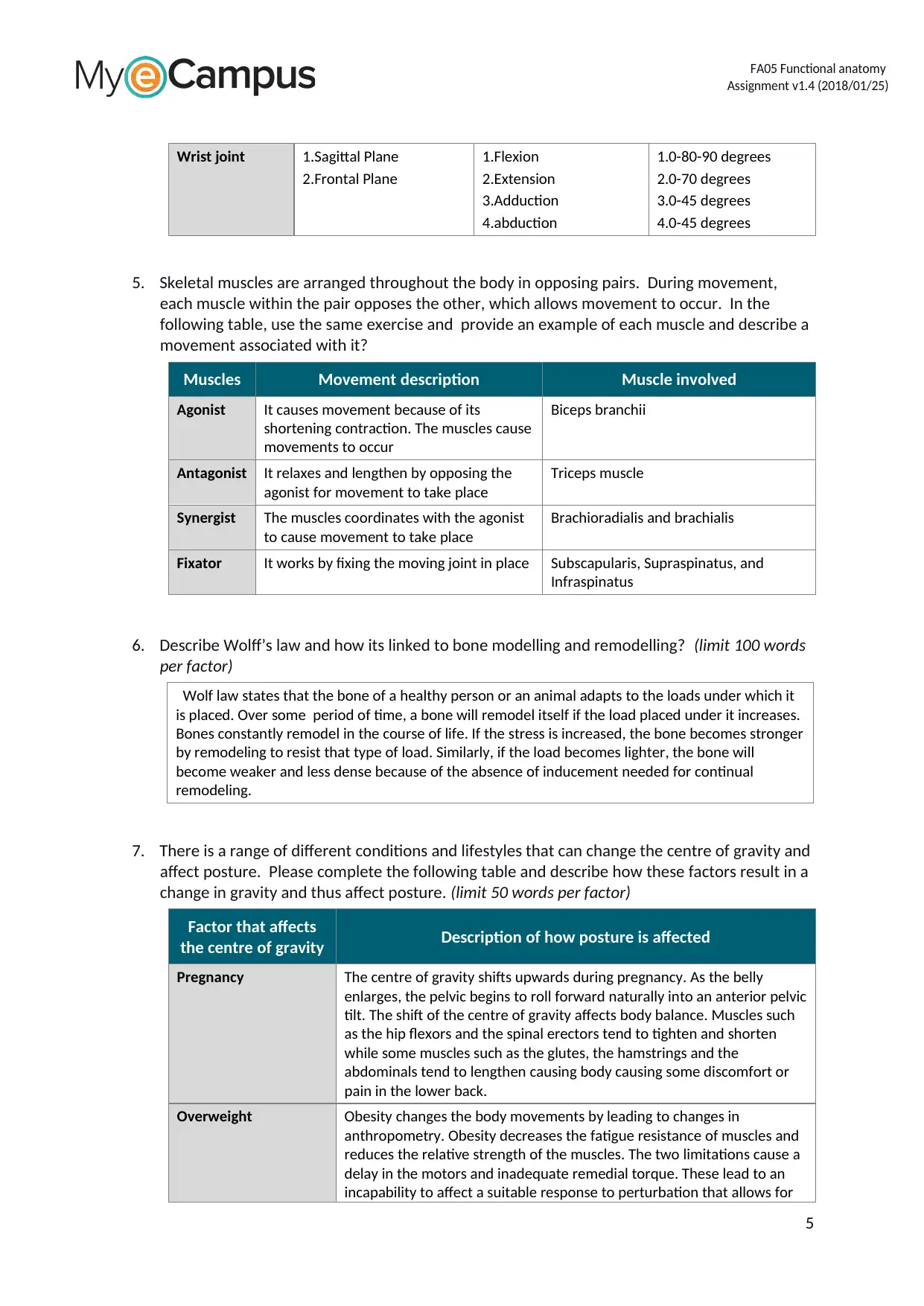
FA05 Functional anatomy
Assignment v1.4 (2018/01/25)
Wrist joint 1.Sagittal Plane
2.Frontal Plane
1.Flexion
2.Extension
3.Adduction
4.abduction
1.0-80-90 degrees
2.0-70 degrees
3.0-45 degrees
4.0-45 degrees
5. Skeletal muscles are arranged throughout the body in opposing pairs. During movement,
each muscle within the pair opposes the other, which allows movement to occur. In the
following table, use the same exercise and provide an example of each muscle and describe a
movement associated with it?
Muscles Movement description Muscle involved
Agonist It causes movement because of its
shortening contraction. The muscles cause
movements to occur
Biceps branchii
Antagonist It relaxes and lengthen by opposing the
agonist for movement to take place
Triceps muscle
Synergist The muscles coordinates with the agonist
to cause movement to take place
Brachioradialis and brachialis
Fixator It works by fixing the moving joint in place Subscapularis, Supraspinatus, and
Infraspinatus
6. Describe Wolff’s law and how its linked to bone modelling and remodelling? (limit 100 words
per factor)
Wolf law states that the bone of a healthy person or an animal adapts to the loads under which it
is placed. Over some period of time, a bone will remodel itself if the load placed under it increases.
Bones constantly remodel in the course of life. If the stress is increased, the bone becomes stronger
by remodeling to resist that type of load. Similarly, if the load becomes lighter, the bone will
become weaker and less dense because of the absence of inducement needed for continual
remodeling.
7. There is a range of different conditions and lifestyles that can change the centre of gravity and
affect posture. Please complete the following table and describe how these factors result in a
change in gravity and thus affect posture. (limit 50 words per factor)
Factor that affects
the centre of gravity Description of how posture is affected
Pregnancy The centre of gravity shifts upwards during pregnancy. As the belly
enlarges, the pelvic begins to roll forward naturally into an anterior pelvic
tilt. The shift of the centre of gravity affects body balance. Muscles such
as the hip flexors and the spinal erectors tend to tighten and shorten
while some muscles such as the glutes, the hamstrings and the
abdominals tend to lengthen causing body causing some discomfort or
pain in the lower back.
Overweight Obesity changes the body movements by leading to changes in
anthropometry. Obesity decreases the fatigue resistance of muscles and
reduces the relative strength of the muscles. The two limitations cause a
delay in the motors and inadequate remedial torque. These lead to an
incapability to affect a suitable response to perturbation that allows for
5
Assignment v1.4 (2018/01/25)
Wrist joint 1.Sagittal Plane
2.Frontal Plane
1.Flexion
2.Extension
3.Adduction
4.abduction
1.0-80-90 degrees
2.0-70 degrees
3.0-45 degrees
4.0-45 degrees
5. Skeletal muscles are arranged throughout the body in opposing pairs. During movement,
each muscle within the pair opposes the other, which allows movement to occur. In the
following table, use the same exercise and provide an example of each muscle and describe a
movement associated with it?
Muscles Movement description Muscle involved
Agonist It causes movement because of its
shortening contraction. The muscles cause
movements to occur
Biceps branchii
Antagonist It relaxes and lengthen by opposing the
agonist for movement to take place
Triceps muscle
Synergist The muscles coordinates with the agonist
to cause movement to take place
Brachioradialis and brachialis
Fixator It works by fixing the moving joint in place Subscapularis, Supraspinatus, and
Infraspinatus
6. Describe Wolff’s law and how its linked to bone modelling and remodelling? (limit 100 words
per factor)
Wolf law states that the bone of a healthy person or an animal adapts to the loads under which it
is placed. Over some period of time, a bone will remodel itself if the load placed under it increases.
Bones constantly remodel in the course of life. If the stress is increased, the bone becomes stronger
by remodeling to resist that type of load. Similarly, if the load becomes lighter, the bone will
become weaker and less dense because of the absence of inducement needed for continual
remodeling.
7. There is a range of different conditions and lifestyles that can change the centre of gravity and
affect posture. Please complete the following table and describe how these factors result in a
change in gravity and thus affect posture. (limit 50 words per factor)
Factor that affects
the centre of gravity Description of how posture is affected
Pregnancy The centre of gravity shifts upwards during pregnancy. As the belly
enlarges, the pelvic begins to roll forward naturally into an anterior pelvic
tilt. The shift of the centre of gravity affects body balance. Muscles such
as the hip flexors and the spinal erectors tend to tighten and shorten
while some muscles such as the glutes, the hamstrings and the
abdominals tend to lengthen causing body causing some discomfort or
pain in the lower back.
Overweight Obesity changes the body movements by leading to changes in
anthropometry. Obesity decreases the fatigue resistance of muscles and
reduces the relative strength of the muscles. The two limitations cause a
delay in the motors and inadequate remedial torque. These lead to an
incapability to affect a suitable response to perturbation that allows for
5
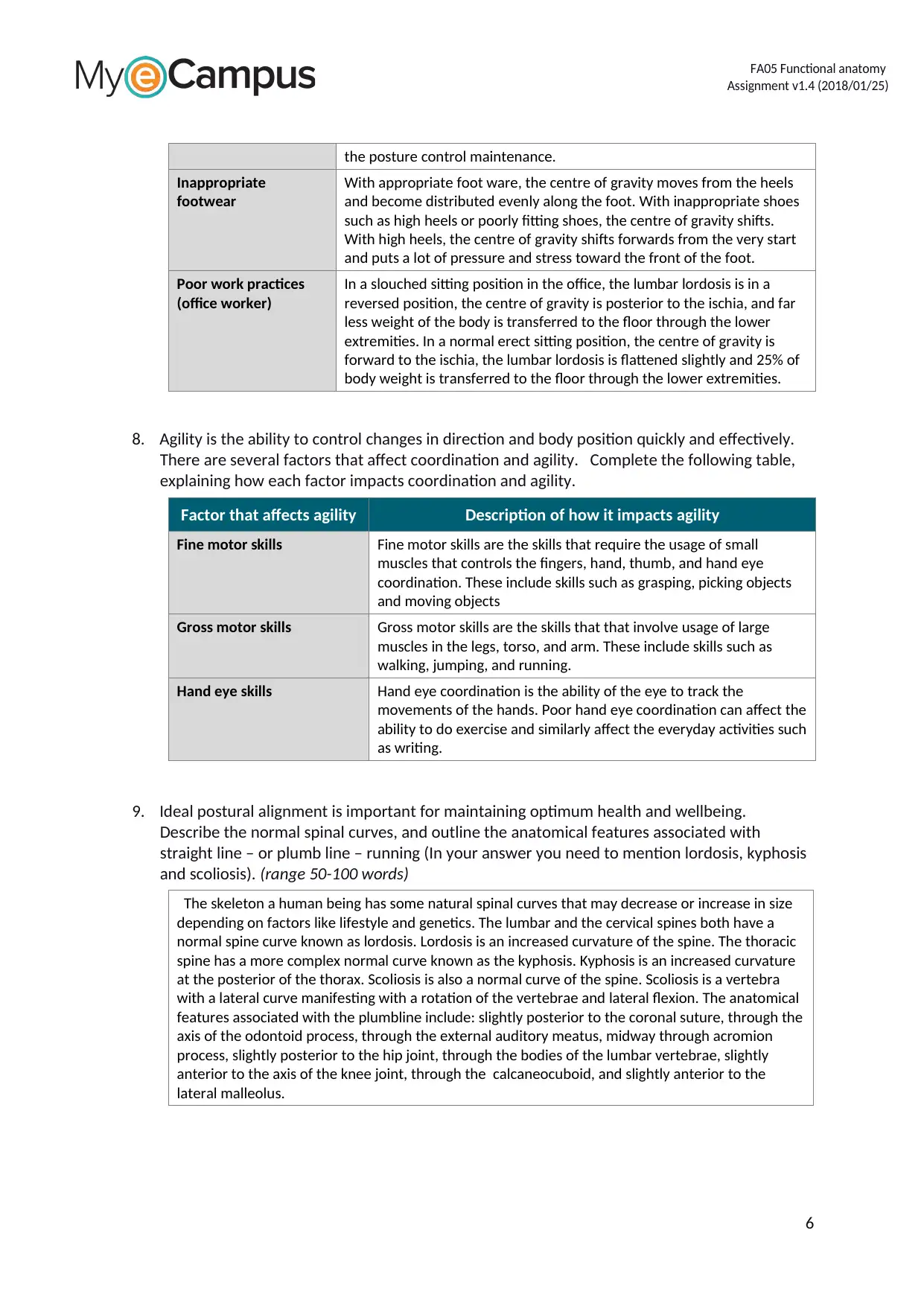
FA05 Functional anatomy
Assignment v1.4 (2018/01/25)
the posture control maintenance.
Inappropriate
footwear
With appropriate foot ware, the centre of gravity moves from the heels
and become distributed evenly along the foot. With inappropriate shoes
such as high heels or poorly fitting shoes, the centre of gravity shifts.
With high heels, the centre of gravity shifts forwards from the very start
and puts a lot of pressure and stress toward the front of the foot.
Poor work practices
(office worker)
In a slouched sitting position in the office, the lumbar lordosis is in a
reversed position, the centre of gravity is posterior to the ischia, and far
less weight of the body is transferred to the floor through the lower
extremities. In a normal erect sitting position, the centre of gravity is
forward to the ischia, the lumbar lordosis is flattened slightly and 25% of
body weight is transferred to the floor through the lower extremities.
8. Agility is the ability to control changes in direction and body position quickly and effectively.
There are several factors that affect coordination and agility. Complete the following table,
explaining how each factor impacts coordination and agility.
Factor that affects agility Description of how it impacts agility
Fine motor skills Fine motor skills are the skills that require the usage of small
muscles that controls the fingers, hand, thumb, and hand eye
coordination. These include skills such as grasping, picking objects
and moving objects
Gross motor skills Gross motor skills are the skills that that involve usage of large
muscles in the legs, torso, and arm. These include skills such as
walking, jumping, and running.
Hand eye skills Hand eye coordination is the ability of the eye to track the
movements of the hands. Poor hand eye coordination can affect the
ability to do exercise and similarly affect the everyday activities such
as writing.
9. Ideal postural alignment is important for maintaining optimum health and wellbeing.
Describe the normal spinal curves, and outline the anatomical features associated with
straight line – or plumb line – running (In your answer you need to mention lordosis, kyphosis
and scoliosis). (range 50-100 words)
The skeleton a human being has some natural spinal curves that may decrease or increase in size
depending on factors like lifestyle and genetics. The lumbar and the cervical spines both have a
normal spine curve known as lordosis. Lordosis is an increased curvature of the spine. The thoracic
spine has a more complex normal curve known as the kyphosis. Kyphosis is an increased curvature
at the posterior of the thorax. Scoliosis is also a normal curve of the spine. Scoliosis is a vertebra
with a lateral curve manifesting with a rotation of the vertebrae and lateral flexion. The anatomical
features associated with the plumbline include: slightly posterior to the coronal suture, through the
axis of the odontoid process, through the external auditory meatus, midway through acromion
process, slightly posterior to the hip joint, through the bodies of the lumbar vertebrae, slightly
anterior to the axis of the knee joint, through the calcaneocuboid, and slightly anterior to the
lateral malleolus.
6
Assignment v1.4 (2018/01/25)
the posture control maintenance.
Inappropriate
footwear
With appropriate foot ware, the centre of gravity moves from the heels
and become distributed evenly along the foot. With inappropriate shoes
such as high heels or poorly fitting shoes, the centre of gravity shifts.
With high heels, the centre of gravity shifts forwards from the very start
and puts a lot of pressure and stress toward the front of the foot.
Poor work practices
(office worker)
In a slouched sitting position in the office, the lumbar lordosis is in a
reversed position, the centre of gravity is posterior to the ischia, and far
less weight of the body is transferred to the floor through the lower
extremities. In a normal erect sitting position, the centre of gravity is
forward to the ischia, the lumbar lordosis is flattened slightly and 25% of
body weight is transferred to the floor through the lower extremities.
8. Agility is the ability to control changes in direction and body position quickly and effectively.
There are several factors that affect coordination and agility. Complete the following table,
explaining how each factor impacts coordination and agility.
Factor that affects agility Description of how it impacts agility
Fine motor skills Fine motor skills are the skills that require the usage of small
muscles that controls the fingers, hand, thumb, and hand eye
coordination. These include skills such as grasping, picking objects
and moving objects
Gross motor skills Gross motor skills are the skills that that involve usage of large
muscles in the legs, torso, and arm. These include skills such as
walking, jumping, and running.
Hand eye skills Hand eye coordination is the ability of the eye to track the
movements of the hands. Poor hand eye coordination can affect the
ability to do exercise and similarly affect the everyday activities such
as writing.
9. Ideal postural alignment is important for maintaining optimum health and wellbeing.
Describe the normal spinal curves, and outline the anatomical features associated with
straight line – or plumb line – running (In your answer you need to mention lordosis, kyphosis
and scoliosis). (range 50-100 words)
The skeleton a human being has some natural spinal curves that may decrease or increase in size
depending on factors like lifestyle and genetics. The lumbar and the cervical spines both have a
normal spine curve known as lordosis. Lordosis is an increased curvature of the spine. The thoracic
spine has a more complex normal curve known as the kyphosis. Kyphosis is an increased curvature
at the posterior of the thorax. Scoliosis is also a normal curve of the spine. Scoliosis is a vertebra
with a lateral curve manifesting with a rotation of the vertebrae and lateral flexion. The anatomical
features associated with the plumbline include: slightly posterior to the coronal suture, through the
axis of the odontoid process, through the external auditory meatus, midway through acromion
process, slightly posterior to the hip joint, through the bodies of the lumbar vertebrae, slightly
anterior to the axis of the knee joint, through the calcaneocuboid, and slightly anterior to the
lateral malleolus.
6
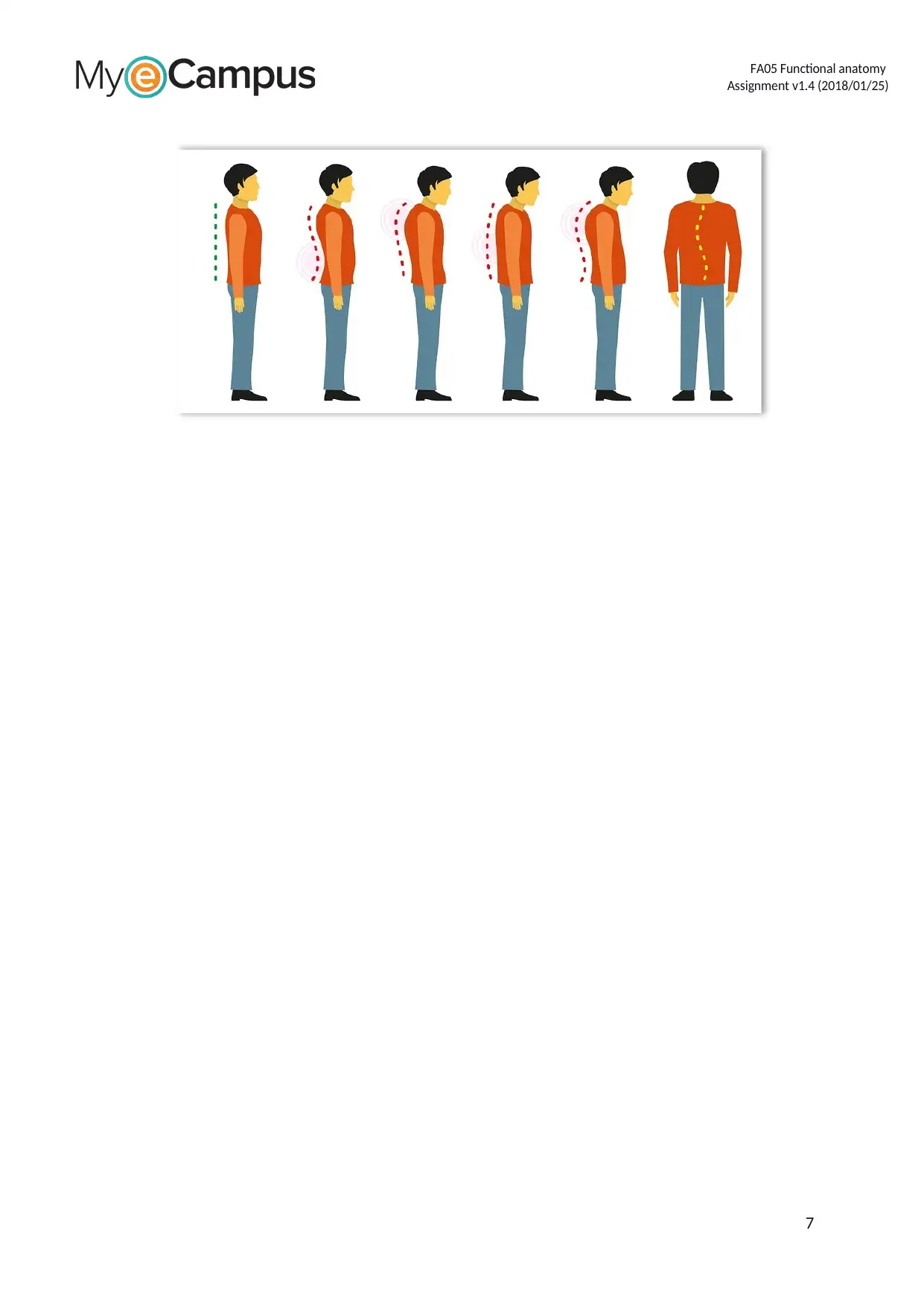
FA05 Functional anatomy
Assignment v1.4 (2018/01/25)
7
Assignment v1.4 (2018/01/25)
7
Paraphrase This Document
Need a fresh take? Get an instant paraphrase of this document with our AI Paraphraser
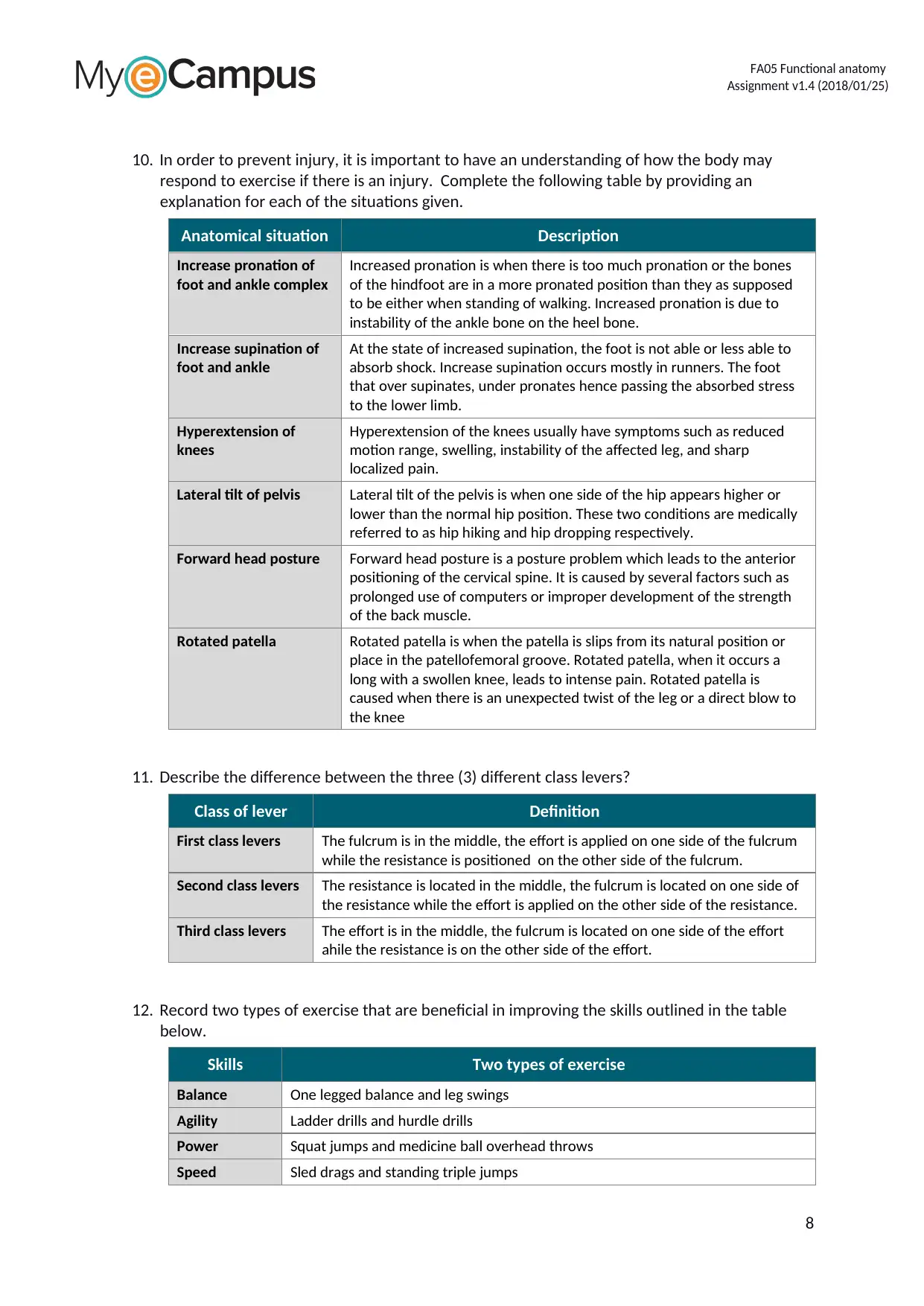
FA05 Functional anatomy
Assignment v1.4 (2018/01/25)
10. In order to prevent injury, it is important to have an understanding of how the body may
respond to exercise if there is an injury. Complete the following table by providing an
explanation for each of the situations given.
Anatomical situation Description
Increase pronation of
foot and ankle complex
Increased pronation is when there is too much pronation or the bones
of the hindfoot are in a more pronated position than they as supposed
to be either when standing of walking. Increased pronation is due to
instability of the ankle bone on the heel bone.
Increase supination of
foot and ankle
At the state of increased supination, the foot is not able or less able to
absorb shock. Increase supination occurs mostly in runners. The foot
that over supinates, under pronates hence passing the absorbed stress
to the lower limb.
Hyperextension of
knees
Hyperextension of the knees usually have symptoms such as reduced
motion range, swelling, instability of the affected leg, and sharp
localized pain.
Lateral tilt of pelvis Lateral tilt of the pelvis is when one side of the hip appears higher or
lower than the normal hip position. These two conditions are medically
referred to as hip hiking and hip dropping respectively.
Forward head posture Forward head posture is a posture problem which leads to the anterior
positioning of the cervical spine. It is caused by several factors such as
prolonged use of computers or improper development of the strength
of the back muscle.
Rotated patella Rotated patella is when the patella is slips from its natural position or
place in the patellofemoral groove. Rotated patella, when it occurs a
long with a swollen knee, leads to intense pain. Rotated patella is
caused when there is an unexpected twist of the leg or a direct blow to
the knee
11. Describe the difference between the three (3) different class levers?
Class of lever Definition
First class levers The fulcrum is in the middle, the effort is applied on one side of the fulcrum
while the resistance is positioned on the other side of the fulcrum.
Second class levers The resistance is located in the middle, the fulcrum is located on one side of
the resistance while the effort is applied on the other side of the resistance.
Third class levers The effort is in the middle, the fulcrum is located on one side of the effort
ahile the resistance is on the other side of the effort.
12. Record two types of exercise that are beneficial in improving the skills outlined in the table
below.
Skills Two types of exercise
Balance One legged balance and leg swings
Agility Ladder drills and hurdle drills
Power Squat jumps and medicine ball overhead throws
Speed Sled drags and standing triple jumps
8
Assignment v1.4 (2018/01/25)
10. In order to prevent injury, it is important to have an understanding of how the body may
respond to exercise if there is an injury. Complete the following table by providing an
explanation for each of the situations given.
Anatomical situation Description
Increase pronation of
foot and ankle complex
Increased pronation is when there is too much pronation or the bones
of the hindfoot are in a more pronated position than they as supposed
to be either when standing of walking. Increased pronation is due to
instability of the ankle bone on the heel bone.
Increase supination of
foot and ankle
At the state of increased supination, the foot is not able or less able to
absorb shock. Increase supination occurs mostly in runners. The foot
that over supinates, under pronates hence passing the absorbed stress
to the lower limb.
Hyperextension of
knees
Hyperextension of the knees usually have symptoms such as reduced
motion range, swelling, instability of the affected leg, and sharp
localized pain.
Lateral tilt of pelvis Lateral tilt of the pelvis is when one side of the hip appears higher or
lower than the normal hip position. These two conditions are medically
referred to as hip hiking and hip dropping respectively.
Forward head posture Forward head posture is a posture problem which leads to the anterior
positioning of the cervical spine. It is caused by several factors such as
prolonged use of computers or improper development of the strength
of the back muscle.
Rotated patella Rotated patella is when the patella is slips from its natural position or
place in the patellofemoral groove. Rotated patella, when it occurs a
long with a swollen knee, leads to intense pain. Rotated patella is
caused when there is an unexpected twist of the leg or a direct blow to
the knee
11. Describe the difference between the three (3) different class levers?
Class of lever Definition
First class levers The fulcrum is in the middle, the effort is applied on one side of the fulcrum
while the resistance is positioned on the other side of the fulcrum.
Second class levers The resistance is located in the middle, the fulcrum is located on one side of
the resistance while the effort is applied on the other side of the resistance.
Third class levers The effort is in the middle, the fulcrum is located on one side of the effort
ahile the resistance is on the other side of the effort.
12. Record two types of exercise that are beneficial in improving the skills outlined in the table
below.
Skills Two types of exercise
Balance One legged balance and leg swings
Agility Ladder drills and hurdle drills
Power Squat jumps and medicine ball overhead throws
Speed Sled drags and standing triple jumps
8
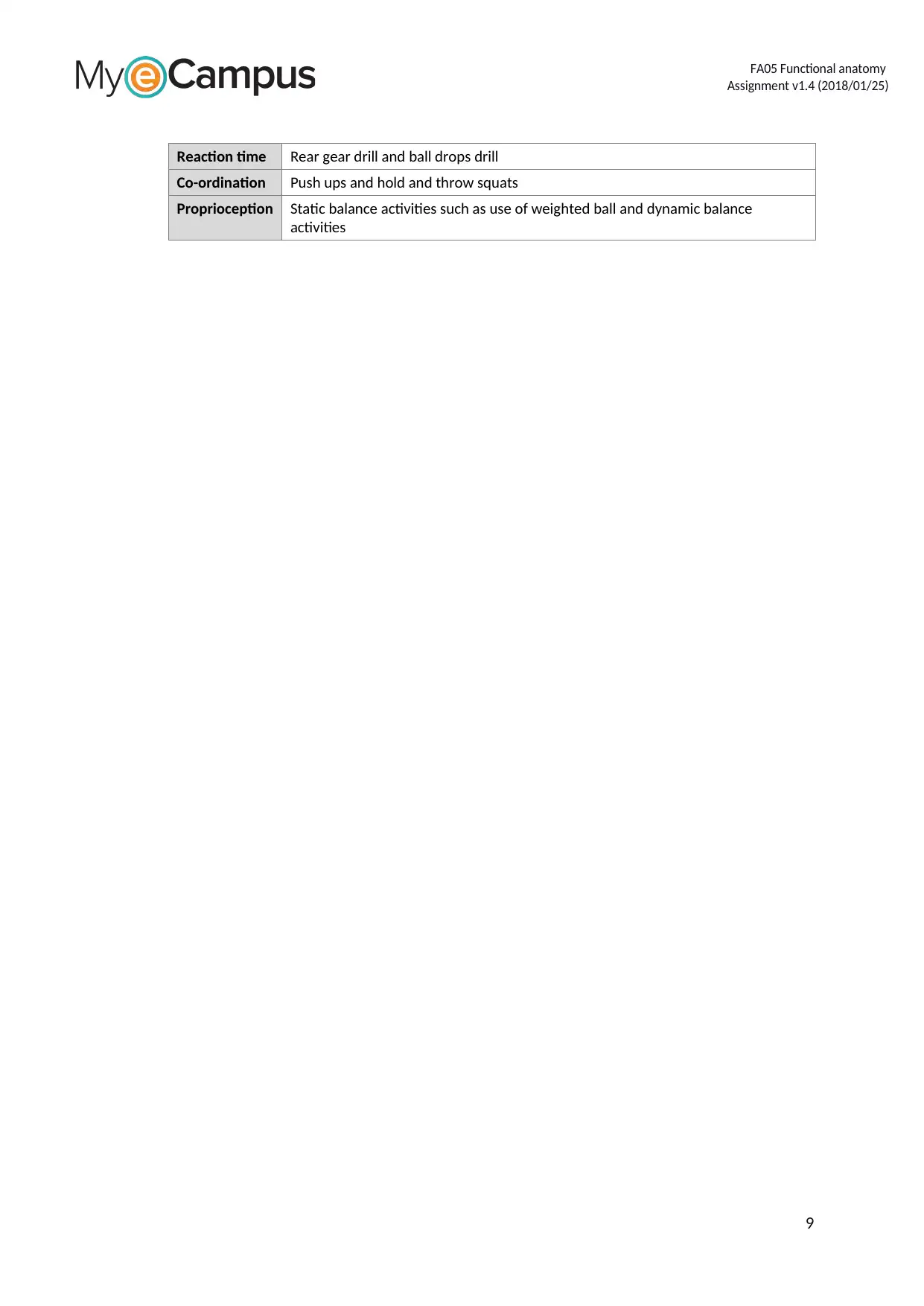
FA05 Functional anatomy
Assignment v1.4 (2018/01/25)
Reaction time Rear gear drill and ball drops drill
Co-ordination Push ups and hold and throw squats
Proprioception Static balance activities such as use of weighted ball and dynamic balance
activities
9
Assignment v1.4 (2018/01/25)
Reaction time Rear gear drill and ball drops drill
Co-ordination Push ups and hold and throw squats
Proprioception Static balance activities such as use of weighted ball and dynamic balance
activities
9
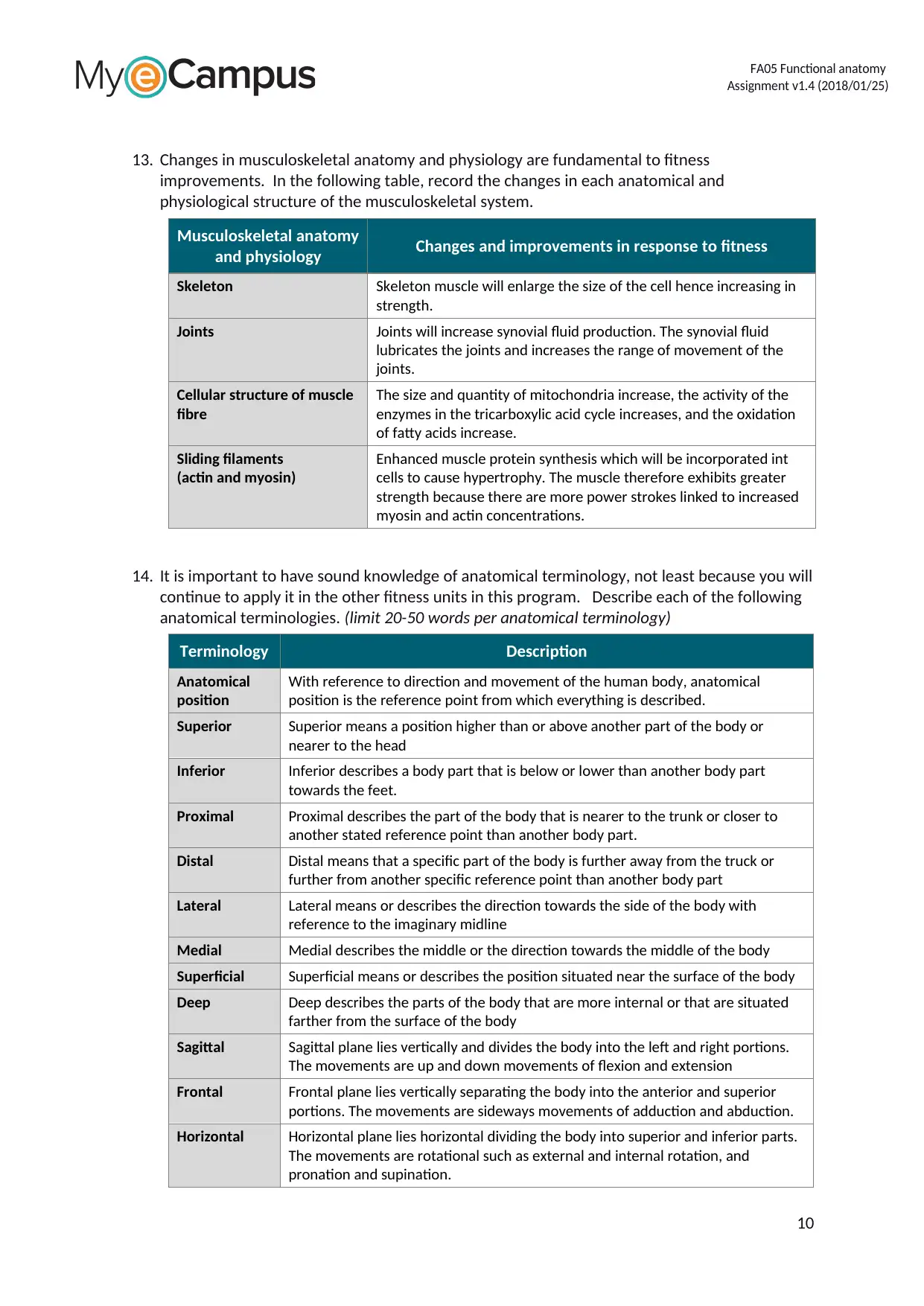
FA05 Functional anatomy
Assignment v1.4 (2018/01/25)
13. Changes in musculoskeletal anatomy and physiology are fundamental to fitness
improvements. In the following table, record the changes in each anatomical and
physiological structure of the musculoskeletal system.
Musculoskeletal anatomy
and physiology Changes and improvements in response to fitness
Skeleton Skeleton muscle will enlarge the size of the cell hence increasing in
strength.
Joints Joints will increase synovial fluid production. The synovial fluid
lubricates the joints and increases the range of movement of the
joints.
Cellular structure of muscle
fibre
The size and quantity of mitochondria increase, the activity of the
enzymes in the tricarboxylic acid cycle increases, and the oxidation
of fatty acids increase.
Sliding filaments
(actin and myosin)
Enhanced muscle protein synthesis which will be incorporated int
cells to cause hypertrophy. The muscle therefore exhibits greater
strength because there are more power strokes linked to increased
myosin and actin concentrations.
14. It is important to have sound knowledge of anatomical terminology, not least because you will
continue to apply it in the other fitness units in this program. Describe each of the following
anatomical terminologies. (limit 20-50 words per anatomical terminology)
Terminology Description
Anatomical
position
With reference to direction and movement of the human body, anatomical
position is the reference point from which everything is described.
Superior Superior means a position higher than or above another part of the body or
nearer to the head
Inferior Inferior describes a body part that is below or lower than another body part
towards the feet.
Proximal Proximal describes the part of the body that is nearer to the trunk or closer to
another stated reference point than another body part.
Distal Distal means that a specific part of the body is further away from the truck or
further from another specific reference point than another body part
Lateral Lateral means or describes the direction towards the side of the body with
reference to the imaginary midline
Medial Medial describes the middle or the direction towards the middle of the body
Superficial Superficial means or describes the position situated near the surface of the body
Deep Deep describes the parts of the body that are more internal or that are situated
farther from the surface of the body
Sagittal Sagittal plane lies vertically and divides the body into the left and right portions.
The movements are up and down movements of flexion and extension
Frontal Frontal plane lies vertically separating the body into the anterior and superior
portions. The movements are sideways movements of adduction and abduction.
Horizontal Horizontal plane lies horizontal dividing the body into superior and inferior parts.
The movements are rotational such as external and internal rotation, and
pronation and supination.
10
Assignment v1.4 (2018/01/25)
13. Changes in musculoskeletal anatomy and physiology are fundamental to fitness
improvements. In the following table, record the changes in each anatomical and
physiological structure of the musculoskeletal system.
Musculoskeletal anatomy
and physiology Changes and improvements in response to fitness
Skeleton Skeleton muscle will enlarge the size of the cell hence increasing in
strength.
Joints Joints will increase synovial fluid production. The synovial fluid
lubricates the joints and increases the range of movement of the
joints.
Cellular structure of muscle
fibre
The size and quantity of mitochondria increase, the activity of the
enzymes in the tricarboxylic acid cycle increases, and the oxidation
of fatty acids increase.
Sliding filaments
(actin and myosin)
Enhanced muscle protein synthesis which will be incorporated int
cells to cause hypertrophy. The muscle therefore exhibits greater
strength because there are more power strokes linked to increased
myosin and actin concentrations.
14. It is important to have sound knowledge of anatomical terminology, not least because you will
continue to apply it in the other fitness units in this program. Describe each of the following
anatomical terminologies. (limit 20-50 words per anatomical terminology)
Terminology Description
Anatomical
position
With reference to direction and movement of the human body, anatomical
position is the reference point from which everything is described.
Superior Superior means a position higher than or above another part of the body or
nearer to the head
Inferior Inferior describes a body part that is below or lower than another body part
towards the feet.
Proximal Proximal describes the part of the body that is nearer to the trunk or closer to
another stated reference point than another body part.
Distal Distal means that a specific part of the body is further away from the truck or
further from another specific reference point than another body part
Lateral Lateral means or describes the direction towards the side of the body with
reference to the imaginary midline
Medial Medial describes the middle or the direction towards the middle of the body
Superficial Superficial means or describes the position situated near the surface of the body
Deep Deep describes the parts of the body that are more internal or that are situated
farther from the surface of the body
Sagittal Sagittal plane lies vertically and divides the body into the left and right portions.
The movements are up and down movements of flexion and extension
Frontal Frontal plane lies vertically separating the body into the anterior and superior
portions. The movements are sideways movements of adduction and abduction.
Horizontal Horizontal plane lies horizontal dividing the body into superior and inferior parts.
The movements are rotational such as external and internal rotation, and
pronation and supination.
10
Secure Best Marks with AI Grader
Need help grading? Try our AI Grader for instant feedback on your assignments.

FA05 Functional anatomy
Assignment v1.4 (2018/01/25)
15. As a personal trainer, it is critical that you have an understanding of the musculoskeletal
system and how joints and muscles work. In the following tables, record the range of motion
and function of each joint and the function of each muscle. (limit 20 words for range of
motion and function)
Joint Joint (ROM) Function of joint
Elbow 0-180 degrees Elbow joint enables the flexion and extension of the
forearm in relation to the upper arm
Knee 0-135 degrees The knee allows for the extension and flexion of the lower
leg in relation to the thigh
Shoulder 0-360 degrees The shoulder is a complex arrangement of ligaments,
bones, muscles and tendons that form the shoulder girdle.
The girdle gives range of motion and strength to the arm.
Hip 0-360 degrees Bears the weight of the body and the weight of the strong
muscles of the legs and the hips
Wrist 0-65-90 degrees The wrist is a collection of many joints and muscles that
connects the hand to the forearm
Ankle 0-20-35-50
degrees
The ankle allows up and down movement of the foot
Muscle Function of muscle
Biceps Controls the movement of the shoulder and the elbow
Tibialis Comprises of the tibialis anterior which functions as a dorsiflexor of the foot
and the tibialis posterior which facilitates foot inversion
Anterior deltoid Anterior deltoid, in corporation with other muscles of the shoulder, alleviates
the shoulder joint and assists in specific forward and rotational arm
movements
Latissimus dorsi Latissimus dorsi functions to medially rotate, adduct, and extend the arms
Pronator teres Rotates the forearm palm-down with the assistance of the pronator quadratus
Hamstring Hamstring helps in bending the knee joint also to rotate the lower leg
Triceps With the assistance of the biceps, the triceps enables the retraction and
extension of the arm
Tensa fascia lata Provides lateral stability to the knee and stabilizes the pelvis too when an
individual stands up straight
16. Describe the effects of aerobic and resistance exercise on the major muscle fibre types (Slow
Twitch (type I), Fast Twitch (type IIa, and type IIb). (limit 150 words)
Slow Twitch (type I- These contract more slowly and respond to a lighter stimulus. Slow twitch
muscles are mostly used for aerobic activities such as long distance running or swimming. These
muscles are more resourceful at the usage of oxygen to make ATP for extended muscles
contraction over a long period of time. Slow Twitch can go for long periods before they fatigue.
While Fast Twitch muscles produce large amounts of force within a short period of time. They are
mostly used in anaerobic activities where fatigue occurs within a short period of time.
11
Assignment v1.4 (2018/01/25)
15. As a personal trainer, it is critical that you have an understanding of the musculoskeletal
system and how joints and muscles work. In the following tables, record the range of motion
and function of each joint and the function of each muscle. (limit 20 words for range of
motion and function)
Joint Joint (ROM) Function of joint
Elbow 0-180 degrees Elbow joint enables the flexion and extension of the
forearm in relation to the upper arm
Knee 0-135 degrees The knee allows for the extension and flexion of the lower
leg in relation to the thigh
Shoulder 0-360 degrees The shoulder is a complex arrangement of ligaments,
bones, muscles and tendons that form the shoulder girdle.
The girdle gives range of motion and strength to the arm.
Hip 0-360 degrees Bears the weight of the body and the weight of the strong
muscles of the legs and the hips
Wrist 0-65-90 degrees The wrist is a collection of many joints and muscles that
connects the hand to the forearm
Ankle 0-20-35-50
degrees
The ankle allows up and down movement of the foot
Muscle Function of muscle
Biceps Controls the movement of the shoulder and the elbow
Tibialis Comprises of the tibialis anterior which functions as a dorsiflexor of the foot
and the tibialis posterior which facilitates foot inversion
Anterior deltoid Anterior deltoid, in corporation with other muscles of the shoulder, alleviates
the shoulder joint and assists in specific forward and rotational arm
movements
Latissimus dorsi Latissimus dorsi functions to medially rotate, adduct, and extend the arms
Pronator teres Rotates the forearm palm-down with the assistance of the pronator quadratus
Hamstring Hamstring helps in bending the knee joint also to rotate the lower leg
Triceps With the assistance of the biceps, the triceps enables the retraction and
extension of the arm
Tensa fascia lata Provides lateral stability to the knee and stabilizes the pelvis too when an
individual stands up straight
16. Describe the effects of aerobic and resistance exercise on the major muscle fibre types (Slow
Twitch (type I), Fast Twitch (type IIa, and type IIb). (limit 150 words)
Slow Twitch (type I- These contract more slowly and respond to a lighter stimulus. Slow twitch
muscles are mostly used for aerobic activities such as long distance running or swimming. These
muscles are more resourceful at the usage of oxygen to make ATP for extended muscles
contraction over a long period of time. Slow Twitch can go for long periods before they fatigue.
While Fast Twitch muscles produce large amounts of force within a short period of time. They are
mostly used in anaerobic activities where fatigue occurs within a short period of time.
11
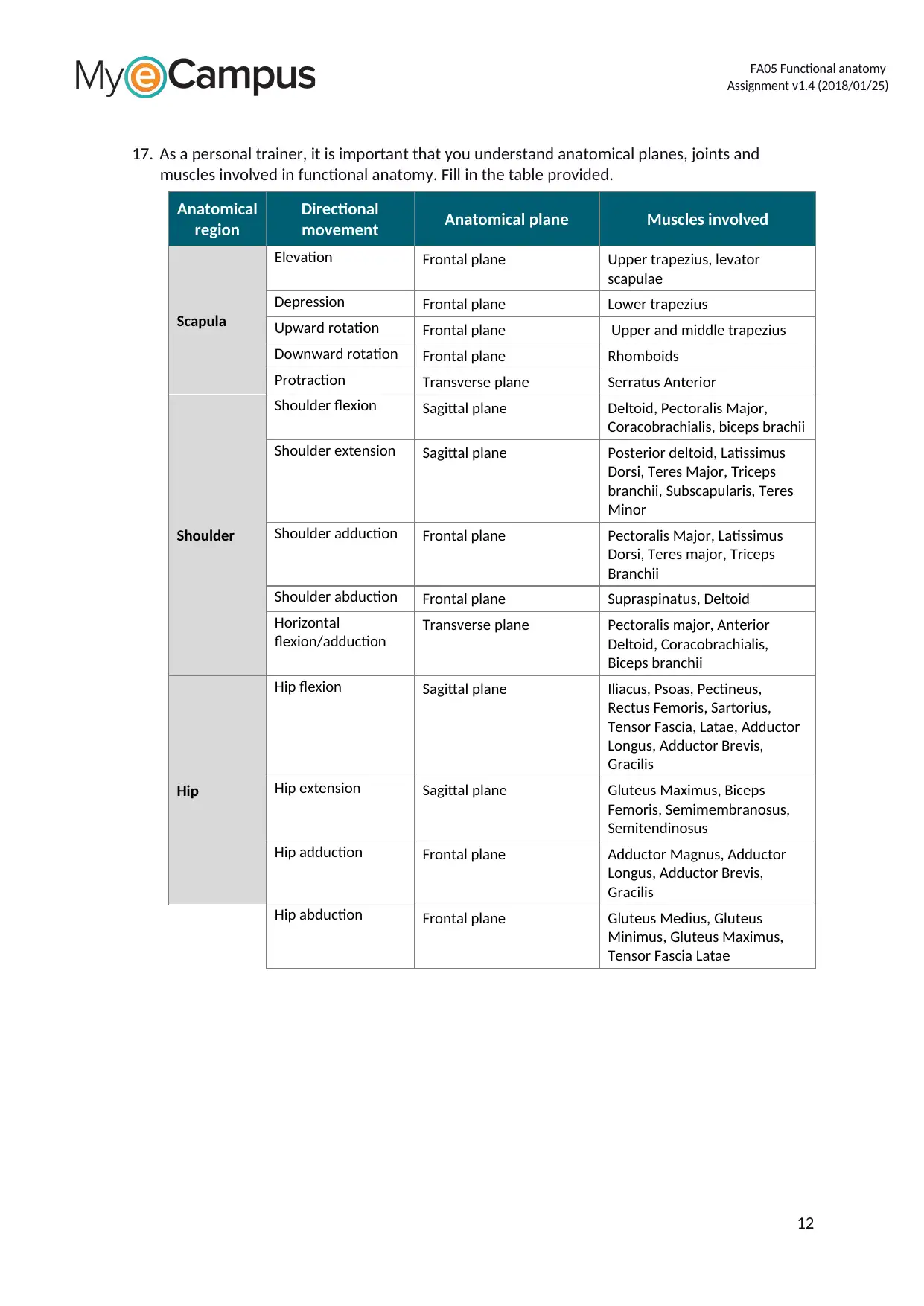
FA05 Functional anatomy
Assignment v1.4 (2018/01/25)
17. As a personal trainer, it is important that you understand anatomical planes, joints and
muscles involved in functional anatomy. Fill in the table provided.
Anatomical
region
Directional
movement Anatomical plane Muscles involved
Scapula
Elevation Frontal plane Upper trapezius, levator
scapulae
Depression Frontal plane Lower trapezius
Upward rotation Frontal plane Upper and middle trapezius
Downward rotation Frontal plane Rhomboids
Protraction Transverse plane Serratus Anterior
Shoulder
Shoulder flexion Sagittal plane Deltoid, Pectoralis Major,
Coracobrachialis, biceps brachii
Shoulder extension Sagittal plane Posterior deltoid, Latissimus
Dorsi, Teres Major, Triceps
branchii, Subscapularis, Teres
Minor
Shoulder adduction Frontal plane Pectoralis Major, Latissimus
Dorsi, Teres major, Triceps
Branchii
Shoulder abduction Frontal plane Supraspinatus, Deltoid
Horizontal
flexion/adduction
Transverse plane Pectoralis major, Anterior
Deltoid, Coracobrachialis,
Biceps branchii
Hip
Hip flexion Sagittal plane Iliacus, Psoas, Pectineus,
Rectus Femoris, Sartorius,
Tensor Fascia, Latae, Adductor
Longus, Adductor Brevis,
Gracilis
Hip extension Sagittal plane Gluteus Maximus, Biceps
Femoris, Semimembranosus,
Semitendinosus
Hip adduction Frontal plane Adductor Magnus, Adductor
Longus, Adductor Brevis,
Gracilis
Hip abduction Frontal plane Gluteus Medius, Gluteus
Minimus, Gluteus Maximus,
Tensor Fascia Latae
12
Assignment v1.4 (2018/01/25)
17. As a personal trainer, it is important that you understand anatomical planes, joints and
muscles involved in functional anatomy. Fill in the table provided.
Anatomical
region
Directional
movement Anatomical plane Muscles involved
Scapula
Elevation Frontal plane Upper trapezius, levator
scapulae
Depression Frontal plane Lower trapezius
Upward rotation Frontal plane Upper and middle trapezius
Downward rotation Frontal plane Rhomboids
Protraction Transverse plane Serratus Anterior
Shoulder
Shoulder flexion Sagittal plane Deltoid, Pectoralis Major,
Coracobrachialis, biceps brachii
Shoulder extension Sagittal plane Posterior deltoid, Latissimus
Dorsi, Teres Major, Triceps
branchii, Subscapularis, Teres
Minor
Shoulder adduction Frontal plane Pectoralis Major, Latissimus
Dorsi, Teres major, Triceps
Branchii
Shoulder abduction Frontal plane Supraspinatus, Deltoid
Horizontal
flexion/adduction
Transverse plane Pectoralis major, Anterior
Deltoid, Coracobrachialis,
Biceps branchii
Hip
Hip flexion Sagittal plane Iliacus, Psoas, Pectineus,
Rectus Femoris, Sartorius,
Tensor Fascia, Latae, Adductor
Longus, Adductor Brevis,
Gracilis
Hip extension Sagittal plane Gluteus Maximus, Biceps
Femoris, Semimembranosus,
Semitendinosus
Hip adduction Frontal plane Adductor Magnus, Adductor
Longus, Adductor Brevis,
Gracilis
Hip abduction Frontal plane Gluteus Medius, Gluteus
Minimus, Gluteus Maximus,
Tensor Fascia Latae
12

FA05 Functional anatomy
Assignment v1.4 (2018/01/25)
18. Describe the location and function of two upper skeletal muscles and two lower skeletal
muscles and their involvement in physical activity. (limit 150 words)
Upper Skeletal
Muscle Location Function
Latissimus dorsi Located at the lumbar region of the
back
Adducts, extends and rotates the arm
at the shoulder
Erector spinae Runs from the cranium to the sacrum Extends the joints of the vertebral
column
Lower Skeletal
Muscle Location Function
Hamstring Located at the back of the upper leg Aids in bending the knee joint as well
as rotating the lower leg
Tibialis anterior Located near the shin Acts as the dorsiflexor of the foot
which is pulling the foot towards the
shin
19. Describe the role of the central and peripheral nervous systems, including somatic and
autonomic nervous systems, in the control of skeletal muscle. In your response, you will need
to highlight the following:
a) Nervous control and nerve impulse
b) Structure and function of a neuron
c) Role of a motor neuron
d) Role of the muscle proprioceptors and the stretch reflex
The somatic nervous system forms part of the peripheral nervous system. The somatic nervous
system transmits signals from the central nervous system to the muscles of the skeleton. The
autonomic nervous system also forms part of the peripheral nervous system that acts involuntarily
without the control of the conscious. The central nervous system assimilates information from the
peripheral nervous system and responds or decides on what kind of action is to be taken
concerning a particular issue. Motor neurons relay or carry information from the peripheral
nervous system to the central nervous system. A motor neuron has an axion, the cell body, and the
dendrites. The axon transports electrical impulses away from the cell body to the muscles for
contraction. The electrical impulses that travel along the axon leads to a nerve impulse.
Proprioceptors are muscles that relay information to the central nervous system concerning the
dynamics of the muscle since they are very sensitive to both tension and pressure. While the
muscle spindles control contraction of muscles by stimulating the motor neurons through the
stretch reflex to resist stretching of the muscle.
20. Define reciprocal inhibition and its relevance to exercise. (limit 50 words)
Reciprocal inhibition is whereby the muscles on one side of a joint relaxes to allow for contraction
on the other side of that joint. Control of the joints is done by the extensors and the flexors, which
work in complete synchrony for smooth movement of joints.
21. Describe the neuromuscular adaptations to exercise and the benefits that occur due to
exercise performance on neuromuscular coordination. (limit 100 words)
13
Assignment v1.4 (2018/01/25)
18. Describe the location and function of two upper skeletal muscles and two lower skeletal
muscles and their involvement in physical activity. (limit 150 words)
Upper Skeletal
Muscle Location Function
Latissimus dorsi Located at the lumbar region of the
back
Adducts, extends and rotates the arm
at the shoulder
Erector spinae Runs from the cranium to the sacrum Extends the joints of the vertebral
column
Lower Skeletal
Muscle Location Function
Hamstring Located at the back of the upper leg Aids in bending the knee joint as well
as rotating the lower leg
Tibialis anterior Located near the shin Acts as the dorsiflexor of the foot
which is pulling the foot towards the
shin
19. Describe the role of the central and peripheral nervous systems, including somatic and
autonomic nervous systems, in the control of skeletal muscle. In your response, you will need
to highlight the following:
a) Nervous control and nerve impulse
b) Structure and function of a neuron
c) Role of a motor neuron
d) Role of the muscle proprioceptors and the stretch reflex
The somatic nervous system forms part of the peripheral nervous system. The somatic nervous
system transmits signals from the central nervous system to the muscles of the skeleton. The
autonomic nervous system also forms part of the peripheral nervous system that acts involuntarily
without the control of the conscious. The central nervous system assimilates information from the
peripheral nervous system and responds or decides on what kind of action is to be taken
concerning a particular issue. Motor neurons relay or carry information from the peripheral
nervous system to the central nervous system. A motor neuron has an axion, the cell body, and the
dendrites. The axon transports electrical impulses away from the cell body to the muscles for
contraction. The electrical impulses that travel along the axon leads to a nerve impulse.
Proprioceptors are muscles that relay information to the central nervous system concerning the
dynamics of the muscle since they are very sensitive to both tension and pressure. While the
muscle spindles control contraction of muscles by stimulating the motor neurons through the
stretch reflex to resist stretching of the muscle.
20. Define reciprocal inhibition and its relevance to exercise. (limit 50 words)
Reciprocal inhibition is whereby the muscles on one side of a joint relaxes to allow for contraction
on the other side of that joint. Control of the joints is done by the extensors and the flexors, which
work in complete synchrony for smooth movement of joints.
21. Describe the neuromuscular adaptations to exercise and the benefits that occur due to
exercise performance on neuromuscular coordination. (limit 100 words)
13
Paraphrase This Document
Need a fresh take? Get an instant paraphrase of this document with our AI Paraphraser
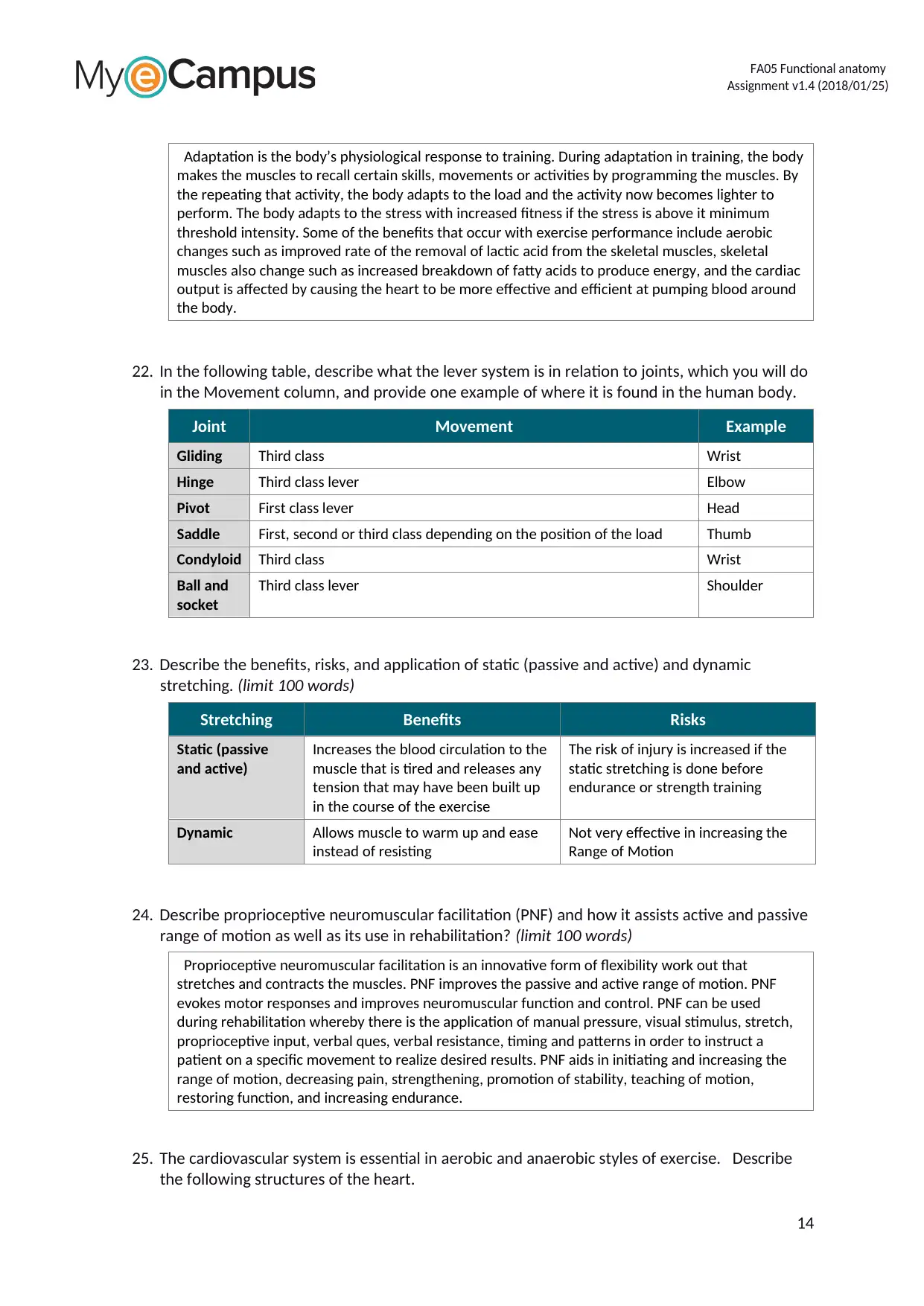
FA05 Functional anatomy
Assignment v1.4 (2018/01/25)
Adaptation is the body’s physiological response to training. During adaptation in training, the body
makes the muscles to recall certain skills, movements or activities by programming the muscles. By
the repeating that activity, the body adapts to the load and the activity now becomes lighter to
perform. The body adapts to the stress with increased fitness if the stress is above it minimum
threshold intensity. Some of the benefits that occur with exercise performance include aerobic
changes such as improved rate of the removal of lactic acid from the skeletal muscles, skeletal
muscles also change such as increased breakdown of fatty acids to produce energy, and the cardiac
output is affected by causing the heart to be more effective and efficient at pumping blood around
the body.
22. In the following table, describe what the lever system is in relation to joints, which you will do
in the Movement column, and provide one example of where it is found in the human body.
Joint Movement Example
Gliding Third class Wrist
Hinge Third class lever Elbow
Pivot First class lever Head
Saddle First, second or third class depending on the position of the load Thumb
Condyloid Third class Wrist
Ball and
socket
Third class lever Shoulder
23. Describe the benefits, risks, and application of static (passive and active) and dynamic
stretching. (limit 100 words)
Stretching Benefits Risks
Static (passive
and active)
Increases the blood circulation to the
muscle that is tired and releases any
tension that may have been built up
in the course of the exercise
The risk of injury is increased if the
static stretching is done before
endurance or strength training
Dynamic Allows muscle to warm up and ease
instead of resisting
Not very effective in increasing the
Range of Motion
24. Describe proprioceptive neuromuscular facilitation (PNF) and how it assists active and passive
range of motion as well as its use in rehabilitation? (limit 100 words)
Proprioceptive neuromuscular facilitation is an innovative form of flexibility work out that
stretches and contracts the muscles. PNF improves the passive and active range of motion. PNF
evokes motor responses and improves neuromuscular function and control. PNF can be used
during rehabilitation whereby there is the application of manual pressure, visual stimulus, stretch,
proprioceptive input, verbal ques, verbal resistance, timing and patterns in order to instruct a
patient on a specific movement to realize desired results. PNF aids in initiating and increasing the
range of motion, decreasing pain, strengthening, promotion of stability, teaching of motion,
restoring function, and increasing endurance.
25. The cardiovascular system is essential in aerobic and anaerobic styles of exercise. Describe
the following structures of the heart.
14
Assignment v1.4 (2018/01/25)
Adaptation is the body’s physiological response to training. During adaptation in training, the body
makes the muscles to recall certain skills, movements or activities by programming the muscles. By
the repeating that activity, the body adapts to the load and the activity now becomes lighter to
perform. The body adapts to the stress with increased fitness if the stress is above it minimum
threshold intensity. Some of the benefits that occur with exercise performance include aerobic
changes such as improved rate of the removal of lactic acid from the skeletal muscles, skeletal
muscles also change such as increased breakdown of fatty acids to produce energy, and the cardiac
output is affected by causing the heart to be more effective and efficient at pumping blood around
the body.
22. In the following table, describe what the lever system is in relation to joints, which you will do
in the Movement column, and provide one example of where it is found in the human body.
Joint Movement Example
Gliding Third class Wrist
Hinge Third class lever Elbow
Pivot First class lever Head
Saddle First, second or third class depending on the position of the load Thumb
Condyloid Third class Wrist
Ball and
socket
Third class lever Shoulder
23. Describe the benefits, risks, and application of static (passive and active) and dynamic
stretching. (limit 100 words)
Stretching Benefits Risks
Static (passive
and active)
Increases the blood circulation to the
muscle that is tired and releases any
tension that may have been built up
in the course of the exercise
The risk of injury is increased if the
static stretching is done before
endurance or strength training
Dynamic Allows muscle to warm up and ease
instead of resisting
Not very effective in increasing the
Range of Motion
24. Describe proprioceptive neuromuscular facilitation (PNF) and how it assists active and passive
range of motion as well as its use in rehabilitation? (limit 100 words)
Proprioceptive neuromuscular facilitation is an innovative form of flexibility work out that
stretches and contracts the muscles. PNF improves the passive and active range of motion. PNF
evokes motor responses and improves neuromuscular function and control. PNF can be used
during rehabilitation whereby there is the application of manual pressure, visual stimulus, stretch,
proprioceptive input, verbal ques, verbal resistance, timing and patterns in order to instruct a
patient on a specific movement to realize desired results. PNF aids in initiating and increasing the
range of motion, decreasing pain, strengthening, promotion of stability, teaching of motion,
restoring function, and increasing endurance.
25. The cardiovascular system is essential in aerobic and anaerobic styles of exercise. Describe
the following structures of the heart.
14
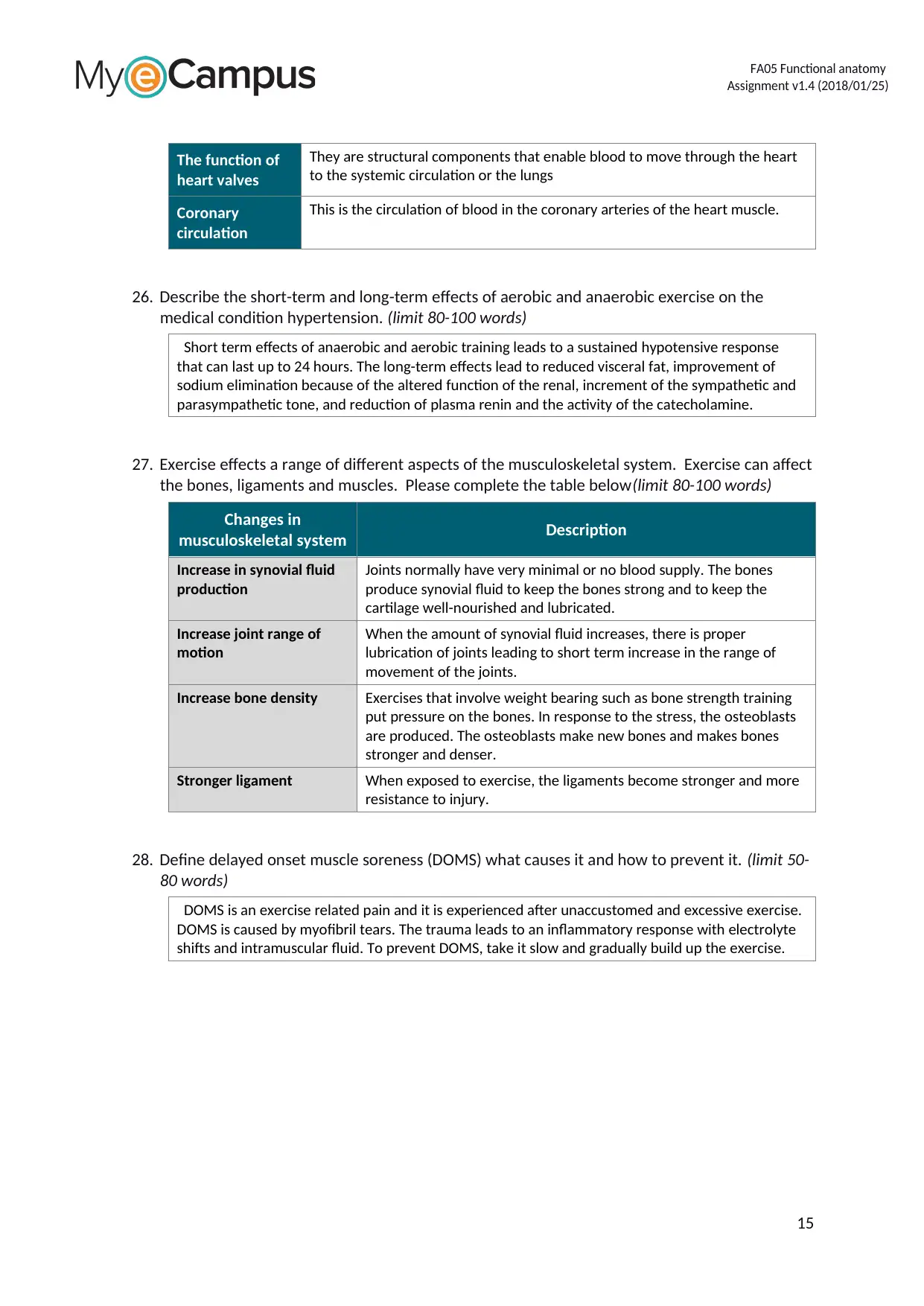
FA05 Functional anatomy
Assignment v1.4 (2018/01/25)
The function of
heart valves
They are structural components that enable blood to move through the heart
to the systemic circulation or the lungs
Coronary
circulation
This is the circulation of blood in the coronary arteries of the heart muscle.
26. Describe the short-term and long-term effects of aerobic and anaerobic exercise on the
medical condition hypertension. (limit 80-100 words)
Short term effects of anaerobic and aerobic training leads to a sustained hypotensive response
that can last up to 24 hours. The long-term effects lead to reduced visceral fat, improvement of
sodium elimination because of the altered function of the renal, increment of the sympathetic and
parasympathetic tone, and reduction of plasma renin and the activity of the catecholamine.
27. Exercise effects a range of different aspects of the musculoskeletal system. Exercise can affect
the bones, ligaments and muscles. Please complete the table below(limit 80-100 words)
Changes in
musculoskeletal system Description
Increase in synovial fluid
production
Joints normally have very minimal or no blood supply. The bones
produce synovial fluid to keep the bones strong and to keep the
cartilage well-nourished and lubricated.
Increase joint range of
motion
When the amount of synovial fluid increases, there is proper
lubrication of joints leading to short term increase in the range of
movement of the joints.
Increase bone density Exercises that involve weight bearing such as bone strength training
put pressure on the bones. In response to the stress, the osteoblasts
are produced. The osteoblasts make new bones and makes bones
stronger and denser.
Stronger ligament When exposed to exercise, the ligaments become stronger and more
resistance to injury.
28. Define delayed onset muscle soreness (DOMS) what causes it and how to prevent it. (limit 50-
80 words)
DOMS is an exercise related pain and it is experienced after unaccustomed and excessive exercise.
DOMS is caused by myofibril tears. The trauma leads to an inflammatory response with electrolyte
shifts and intramuscular fluid. To prevent DOMS, take it slow and gradually build up the exercise.
15
Assignment v1.4 (2018/01/25)
The function of
heart valves
They are structural components that enable blood to move through the heart
to the systemic circulation or the lungs
Coronary
circulation
This is the circulation of blood in the coronary arteries of the heart muscle.
26. Describe the short-term and long-term effects of aerobic and anaerobic exercise on the
medical condition hypertension. (limit 80-100 words)
Short term effects of anaerobic and aerobic training leads to a sustained hypotensive response
that can last up to 24 hours. The long-term effects lead to reduced visceral fat, improvement of
sodium elimination because of the altered function of the renal, increment of the sympathetic and
parasympathetic tone, and reduction of plasma renin and the activity of the catecholamine.
27. Exercise effects a range of different aspects of the musculoskeletal system. Exercise can affect
the bones, ligaments and muscles. Please complete the table below(limit 80-100 words)
Changes in
musculoskeletal system Description
Increase in synovial fluid
production
Joints normally have very minimal or no blood supply. The bones
produce synovial fluid to keep the bones strong and to keep the
cartilage well-nourished and lubricated.
Increase joint range of
motion
When the amount of synovial fluid increases, there is proper
lubrication of joints leading to short term increase in the range of
movement of the joints.
Increase bone density Exercises that involve weight bearing such as bone strength training
put pressure on the bones. In response to the stress, the osteoblasts
are produced. The osteoblasts make new bones and makes bones
stronger and denser.
Stronger ligament When exposed to exercise, the ligaments become stronger and more
resistance to injury.
28. Define delayed onset muscle soreness (DOMS) what causes it and how to prevent it. (limit 50-
80 words)
DOMS is an exercise related pain and it is experienced after unaccustomed and excessive exercise.
DOMS is caused by myofibril tears. The trauma leads to an inflammatory response with electrolyte
shifts and intramuscular fluid. To prevent DOMS, take it slow and gradually build up the exercise.
15
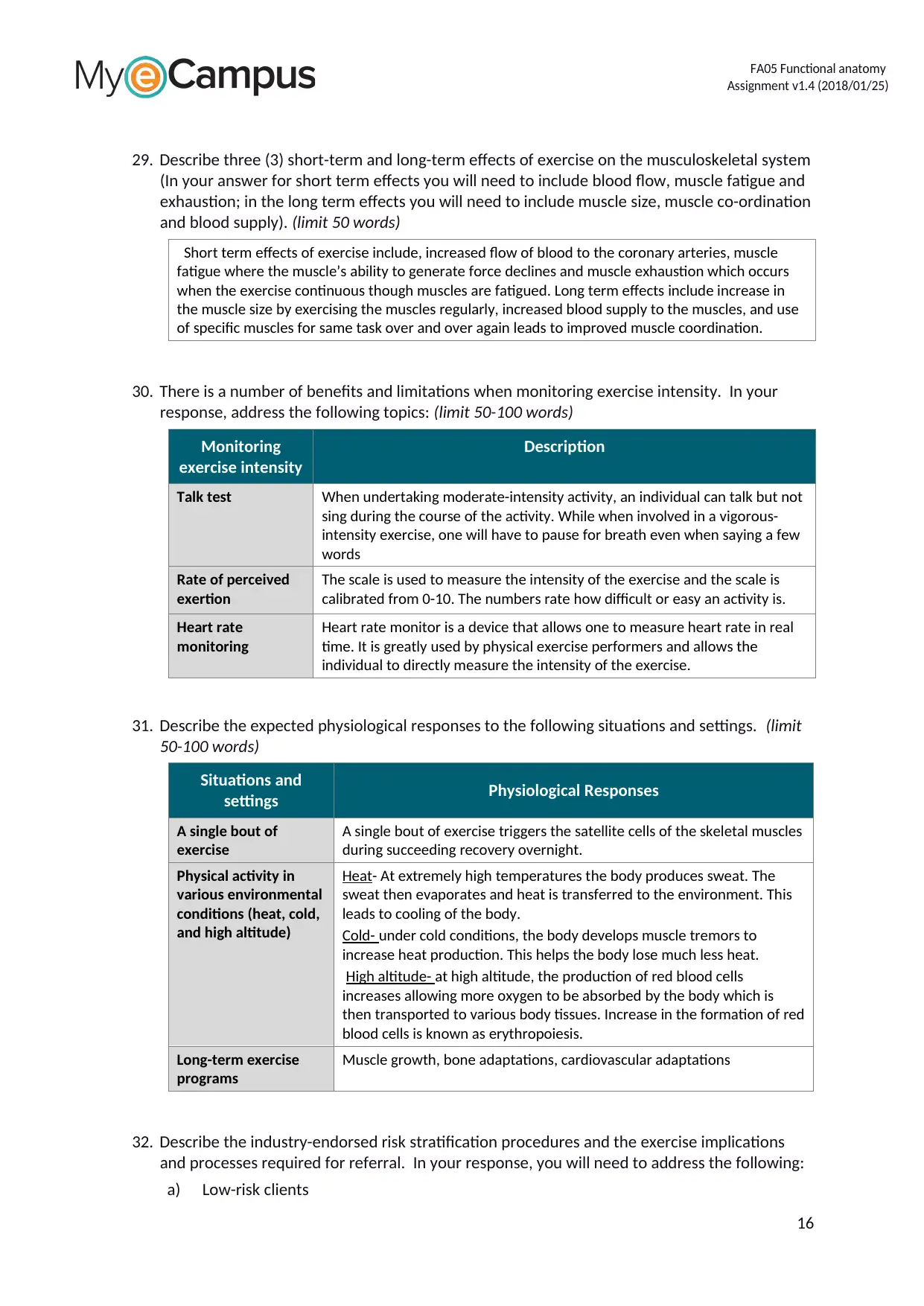
FA05 Functional anatomy
Assignment v1.4 (2018/01/25)
29. Describe three (3) short-term and long-term effects of exercise on the musculoskeletal system
(In your answer for short term effects you will need to include blood flow, muscle fatigue and
exhaustion; in the long term effects you will need to include muscle size, muscle co-ordination
and blood supply). (limit 50 words)
Short term effects of exercise include, increased flow of blood to the coronary arteries, muscle
fatigue where the muscle’s ability to generate force declines and muscle exhaustion which occurs
when the exercise continuous though muscles are fatigued. Long term effects include increase in
the muscle size by exercising the muscles regularly, increased blood supply to the muscles, and use
of specific muscles for same task over and over again leads to improved muscle coordination.
30. There is a number of benefits and limitations when monitoring exercise intensity. In your
response, address the following topics: (limit 50-100 words)
Monitoring
exercise intensity
Description
Talk test When undertaking moderate-intensity activity, an individual can talk but not
sing during the course of the activity. While when involved in a vigorous-
intensity exercise, one will have to pause for breath even when saying a few
words
Rate of perceived
exertion
The scale is used to measure the intensity of the exercise and the scale is
calibrated from 0-10. The numbers rate how difficult or easy an activity is.
Heart rate
monitoring
Heart rate monitor is a device that allows one to measure heart rate in real
time. It is greatly used by physical exercise performers and allows the
individual to directly measure the intensity of the exercise.
31. Describe the expected physiological responses to the following situations and settings. (limit
50-100 words)
Situations and
settings Physiological Responses
A single bout of
exercise
A single bout of exercise triggers the satellite cells of the skeletal muscles
during succeeding recovery overnight.
Physical activity in
various environmental
conditions (heat, cold,
and high altitude)
Heat- At extremely high temperatures the body produces sweat. The
sweat then evaporates and heat is transferred to the environment. This
leads to cooling of the body.
Cold- under cold conditions, the body develops muscle tremors to
increase heat production. This helps the body lose much less heat.
High altitude- at high altitude, the production of red blood cells
increases allowing more oxygen to be absorbed by the body which is
then transported to various body tissues. Increase in the formation of red
blood cells is known as erythropoiesis.
Long-term exercise
programs
Muscle growth, bone adaptations, cardiovascular adaptations
32. Describe the industry-endorsed risk stratification procedures and the exercise implications
and processes required for referral. In your response, you will need to address the following:
a) Low-risk clients
16
Assignment v1.4 (2018/01/25)
29. Describe three (3) short-term and long-term effects of exercise on the musculoskeletal system
(In your answer for short term effects you will need to include blood flow, muscle fatigue and
exhaustion; in the long term effects you will need to include muscle size, muscle co-ordination
and blood supply). (limit 50 words)
Short term effects of exercise include, increased flow of blood to the coronary arteries, muscle
fatigue where the muscle’s ability to generate force declines and muscle exhaustion which occurs
when the exercise continuous though muscles are fatigued. Long term effects include increase in
the muscle size by exercising the muscles regularly, increased blood supply to the muscles, and use
of specific muscles for same task over and over again leads to improved muscle coordination.
30. There is a number of benefits and limitations when monitoring exercise intensity. In your
response, address the following topics: (limit 50-100 words)
Monitoring
exercise intensity
Description
Talk test When undertaking moderate-intensity activity, an individual can talk but not
sing during the course of the activity. While when involved in a vigorous-
intensity exercise, one will have to pause for breath even when saying a few
words
Rate of perceived
exertion
The scale is used to measure the intensity of the exercise and the scale is
calibrated from 0-10. The numbers rate how difficult or easy an activity is.
Heart rate
monitoring
Heart rate monitor is a device that allows one to measure heart rate in real
time. It is greatly used by physical exercise performers and allows the
individual to directly measure the intensity of the exercise.
31. Describe the expected physiological responses to the following situations and settings. (limit
50-100 words)
Situations and
settings Physiological Responses
A single bout of
exercise
A single bout of exercise triggers the satellite cells of the skeletal muscles
during succeeding recovery overnight.
Physical activity in
various environmental
conditions (heat, cold,
and high altitude)
Heat- At extremely high temperatures the body produces sweat. The
sweat then evaporates and heat is transferred to the environment. This
leads to cooling of the body.
Cold- under cold conditions, the body develops muscle tremors to
increase heat production. This helps the body lose much less heat.
High altitude- at high altitude, the production of red blood cells
increases allowing more oxygen to be absorbed by the body which is
then transported to various body tissues. Increase in the formation of red
blood cells is known as erythropoiesis.
Long-term exercise
programs
Muscle growth, bone adaptations, cardiovascular adaptations
32. Describe the industry-endorsed risk stratification procedures and the exercise implications
and processes required for referral. In your response, you will need to address the following:
a) Low-risk clients
16
Secure Best Marks with AI Grader
Need help grading? Try our AI Grader for instant feedback on your assignments.
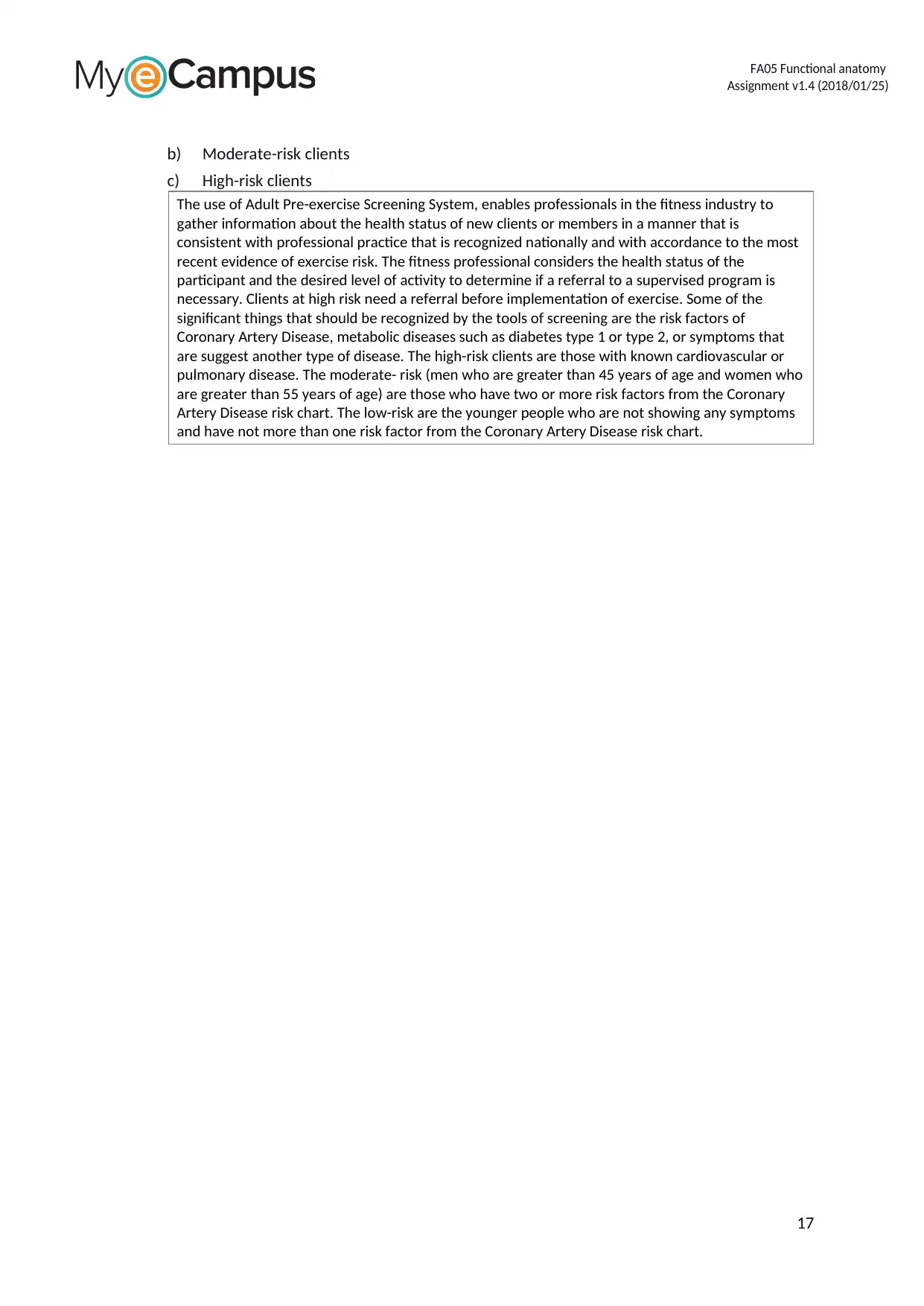
FA05 Functional anatomy
Assignment v1.4 (2018/01/25)
b) Moderate-risk clients
c) High-risk clients
The use of Adult Pre-exercise Screening System, enables professionals in the fitness industry to
gather information about the health status of new clients or members in a manner that is
consistent with professional practice that is recognized nationally and with accordance to the most
recent evidence of exercise risk. The fitness professional considers the health status of the
participant and the desired level of activity to determine if a referral to a supervised program is
necessary. Clients at high risk need a referral before implementation of exercise. Some of the
significant things that should be recognized by the tools of screening are the risk factors of
Coronary Artery Disease, metabolic diseases such as diabetes type 1 or type 2, or symptoms that
are suggest another type of disease. The high-risk clients are those with known cardiovascular or
pulmonary disease. The moderate- risk (men who are greater than 45 years of age and women who
are greater than 55 years of age) are those who have two or more risk factors from the Coronary
Artery Disease risk chart. The low-risk are the younger people who are not showing any symptoms
and have not more than one risk factor from the Coronary Artery Disease risk chart.
17
Assignment v1.4 (2018/01/25)
b) Moderate-risk clients
c) High-risk clients
The use of Adult Pre-exercise Screening System, enables professionals in the fitness industry to
gather information about the health status of new clients or members in a manner that is
consistent with professional practice that is recognized nationally and with accordance to the most
recent evidence of exercise risk. The fitness professional considers the health status of the
participant and the desired level of activity to determine if a referral to a supervised program is
necessary. Clients at high risk need a referral before implementation of exercise. Some of the
significant things that should be recognized by the tools of screening are the risk factors of
Coronary Artery Disease, metabolic diseases such as diabetes type 1 or type 2, or symptoms that
are suggest another type of disease. The high-risk clients are those with known cardiovascular or
pulmonary disease. The moderate- risk (men who are greater than 45 years of age and women who
are greater than 55 years of age) are those who have two or more risk factors from the Coronary
Artery Disease risk chart. The low-risk are the younger people who are not showing any symptoms
and have not more than one risk factor from the Coronary Artery Disease risk chart.
17
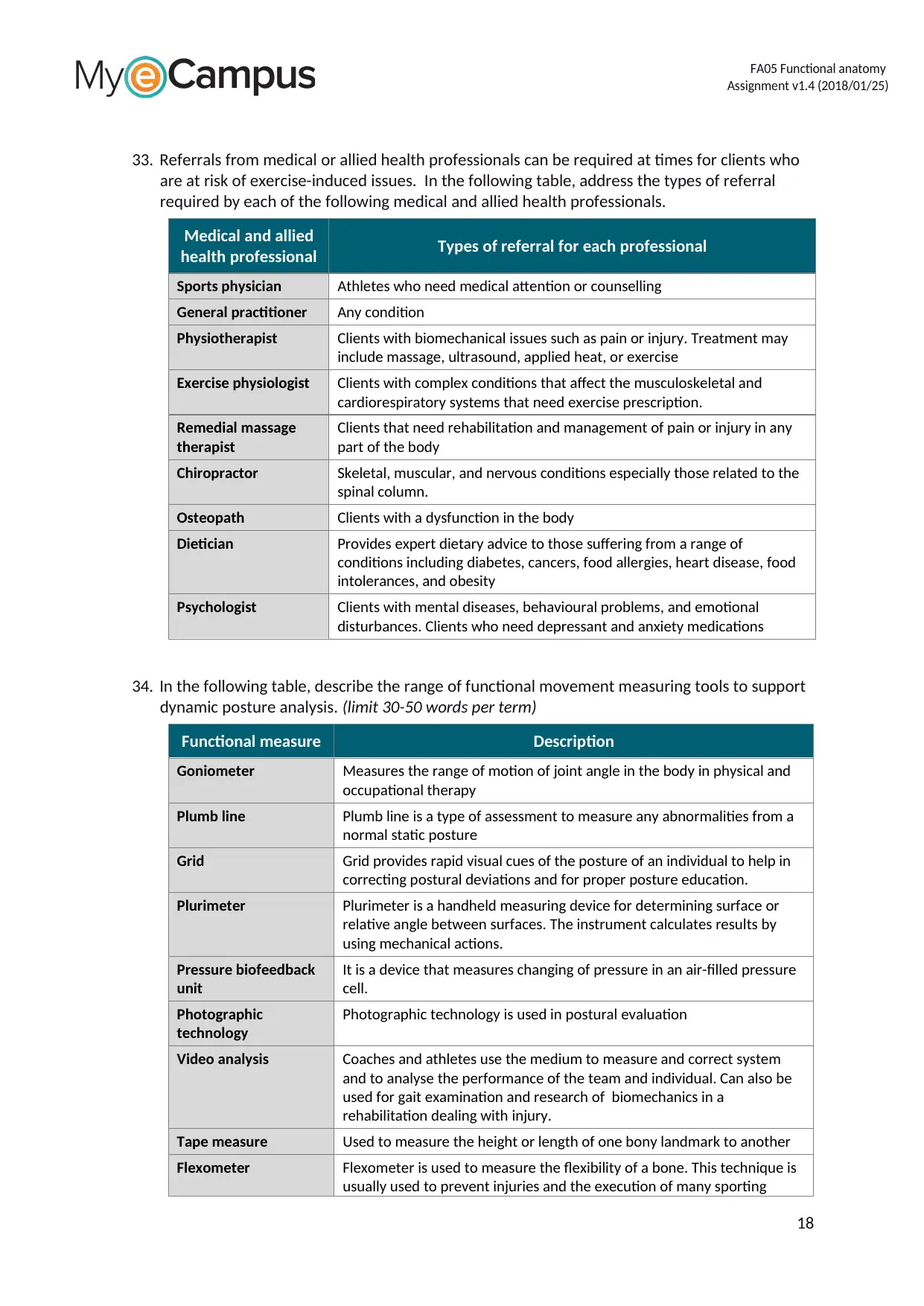
FA05 Functional anatomy
Assignment v1.4 (2018/01/25)
33. Referrals from medical or allied health professionals can be required at times for clients who
are at risk of exercise-induced issues. In the following table, address the types of referral
required by each of the following medical and allied health professionals.
Medical and allied
health professional Types of referral for each professional
Sports physician Athletes who need medical attention or counselling
General practitioner Any condition
Physiotherapist Clients with biomechanical issues such as pain or injury. Treatment may
include massage, ultrasound, applied heat, or exercise
Exercise physiologist Clients with complex conditions that affect the musculoskeletal and
cardiorespiratory systems that need exercise prescription.
Remedial massage
therapist
Clients that need rehabilitation and management of pain or injury in any
part of the body
Chiropractor Skeletal, muscular, and nervous conditions especially those related to the
spinal column.
Osteopath Clients with a dysfunction in the body
Dietician Provides expert dietary advice to those suffering from a range of
conditions including diabetes, cancers, food allergies, heart disease, food
intolerances, and obesity
Psychologist Clients with mental diseases, behavioural problems, and emotional
disturbances. Clients who need depressant and anxiety medications
34. In the following table, describe the range of functional movement measuring tools to support
dynamic posture analysis. (limit 30-50 words per term)
Functional measure Description
Goniometer Measures the range of motion of joint angle in the body in physical and
occupational therapy
Plumb line Plumb line is a type of assessment to measure any abnormalities from a
normal static posture
Grid Grid provides rapid visual cues of the posture of an individual to help in
correcting postural deviations and for proper posture education.
Plurimeter Plurimeter is a handheld measuring device for determining surface or
relative angle between surfaces. The instrument calculates results by
using mechanical actions.
Pressure biofeedback
unit
It is a device that measures changing of pressure in an air-filled pressure
cell.
Photographic
technology
Photographic technology is used in postural evaluation
Video analysis Coaches and athletes use the medium to measure and correct system
and to analyse the performance of the team and individual. Can also be
used for gait examination and research of biomechanics in a
rehabilitation dealing with injury.
Tape measure Used to measure the height or length of one bony landmark to another
Flexometer Flexometer is used to measure the flexibility of a bone. This technique is
usually used to prevent injuries and the execution of many sporting
18
Assignment v1.4 (2018/01/25)
33. Referrals from medical or allied health professionals can be required at times for clients who
are at risk of exercise-induced issues. In the following table, address the types of referral
required by each of the following medical and allied health professionals.
Medical and allied
health professional Types of referral for each professional
Sports physician Athletes who need medical attention or counselling
General practitioner Any condition
Physiotherapist Clients with biomechanical issues such as pain or injury. Treatment may
include massage, ultrasound, applied heat, or exercise
Exercise physiologist Clients with complex conditions that affect the musculoskeletal and
cardiorespiratory systems that need exercise prescription.
Remedial massage
therapist
Clients that need rehabilitation and management of pain or injury in any
part of the body
Chiropractor Skeletal, muscular, and nervous conditions especially those related to the
spinal column.
Osteopath Clients with a dysfunction in the body
Dietician Provides expert dietary advice to those suffering from a range of
conditions including diabetes, cancers, food allergies, heart disease, food
intolerances, and obesity
Psychologist Clients with mental diseases, behavioural problems, and emotional
disturbances. Clients who need depressant and anxiety medications
34. In the following table, describe the range of functional movement measuring tools to support
dynamic posture analysis. (limit 30-50 words per term)
Functional measure Description
Goniometer Measures the range of motion of joint angle in the body in physical and
occupational therapy
Plumb line Plumb line is a type of assessment to measure any abnormalities from a
normal static posture
Grid Grid provides rapid visual cues of the posture of an individual to help in
correcting postural deviations and for proper posture education.
Plurimeter Plurimeter is a handheld measuring device for determining surface or
relative angle between surfaces. The instrument calculates results by
using mechanical actions.
Pressure biofeedback
unit
It is a device that measures changing of pressure in an air-filled pressure
cell.
Photographic
technology
Photographic technology is used in postural evaluation
Video analysis Coaches and athletes use the medium to measure and correct system
and to analyse the performance of the team and individual. Can also be
used for gait examination and research of biomechanics in a
rehabilitation dealing with injury.
Tape measure Used to measure the height or length of one bony landmark to another
Flexometer Flexometer is used to measure the flexibility of a bone. This technique is
usually used to prevent injuries and the execution of many sporting
18
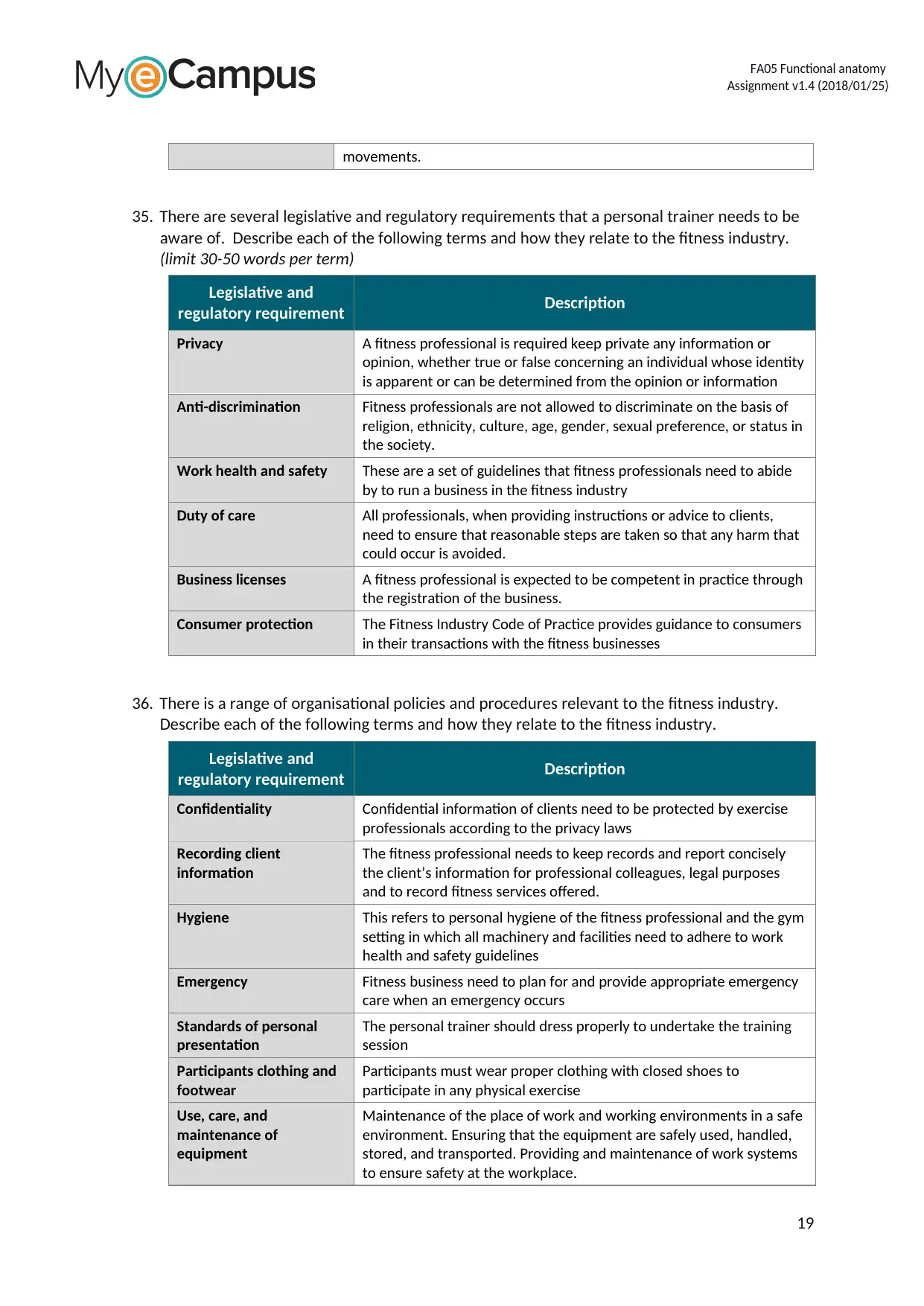
FA05 Functional anatomy
Assignment v1.4 (2018/01/25)
movements.
35. There are several legislative and regulatory requirements that a personal trainer needs to be
aware of. Describe each of the following terms and how they relate to the fitness industry.
(limit 30-50 words per term)
Legislative and
regulatory requirement Description
Privacy A fitness professional is required keep private any information or
opinion, whether true or false concerning an individual whose identity
is apparent or can be determined from the opinion or information
Anti-discrimination Fitness professionals are not allowed to discriminate on the basis of
religion, ethnicity, culture, age, gender, sexual preference, or status in
the society.
Work health and safety These are a set of guidelines that fitness professionals need to abide
by to run a business in the fitness industry
Duty of care All professionals, when providing instructions or advice to clients,
need to ensure that reasonable steps are taken so that any harm that
could occur is avoided.
Business licenses A fitness professional is expected to be competent in practice through
the registration of the business.
Consumer protection The Fitness Industry Code of Practice provides guidance to consumers
in their transactions with the fitness businesses
36. There is a range of organisational policies and procedures relevant to the fitness industry.
Describe each of the following terms and how they relate to the fitness industry.
Legislative and
regulatory requirement Description
Confidentiality Confidential information of clients need to be protected by exercise
professionals according to the privacy laws
Recording client
information
The fitness professional needs to keep records and report concisely
the client’s information for professional colleagues, legal purposes
and to record fitness services offered.
Hygiene This refers to personal hygiene of the fitness professional and the gym
setting in which all machinery and facilities need to adhere to work
health and safety guidelines
Emergency Fitness business need to plan for and provide appropriate emergency
care when an emergency occurs
Standards of personal
presentation
The personal trainer should dress properly to undertake the training
session
Participants clothing and
footwear
Participants must wear proper clothing with closed shoes to
participate in any physical exercise
Use, care, and
maintenance of
equipment
Maintenance of the place of work and working environments in a safe
environment. Ensuring that the equipment are safely used, handled,
stored, and transported. Providing and maintenance of work systems
to ensure safety at the workplace.
19
Assignment v1.4 (2018/01/25)
movements.
35. There are several legislative and regulatory requirements that a personal trainer needs to be
aware of. Describe each of the following terms and how they relate to the fitness industry.
(limit 30-50 words per term)
Legislative and
regulatory requirement Description
Privacy A fitness professional is required keep private any information or
opinion, whether true or false concerning an individual whose identity
is apparent or can be determined from the opinion or information
Anti-discrimination Fitness professionals are not allowed to discriminate on the basis of
religion, ethnicity, culture, age, gender, sexual preference, or status in
the society.
Work health and safety These are a set of guidelines that fitness professionals need to abide
by to run a business in the fitness industry
Duty of care All professionals, when providing instructions or advice to clients,
need to ensure that reasonable steps are taken so that any harm that
could occur is avoided.
Business licenses A fitness professional is expected to be competent in practice through
the registration of the business.
Consumer protection The Fitness Industry Code of Practice provides guidance to consumers
in their transactions with the fitness businesses
36. There is a range of organisational policies and procedures relevant to the fitness industry.
Describe each of the following terms and how they relate to the fitness industry.
Legislative and
regulatory requirement Description
Confidentiality Confidential information of clients need to be protected by exercise
professionals according to the privacy laws
Recording client
information
The fitness professional needs to keep records and report concisely
the client’s information for professional colleagues, legal purposes
and to record fitness services offered.
Hygiene This refers to personal hygiene of the fitness professional and the gym
setting in which all machinery and facilities need to adhere to work
health and safety guidelines
Emergency Fitness business need to plan for and provide appropriate emergency
care when an emergency occurs
Standards of personal
presentation
The personal trainer should dress properly to undertake the training
session
Participants clothing and
footwear
Participants must wear proper clothing with closed shoes to
participate in any physical exercise
Use, care, and
maintenance of
equipment
Maintenance of the place of work and working environments in a safe
environment. Ensuring that the equipment are safely used, handled,
stored, and transported. Providing and maintenance of work systems
to ensure safety at the workplace.
19
Paraphrase This Document
Need a fresh take? Get an instant paraphrase of this document with our AI Paraphraser
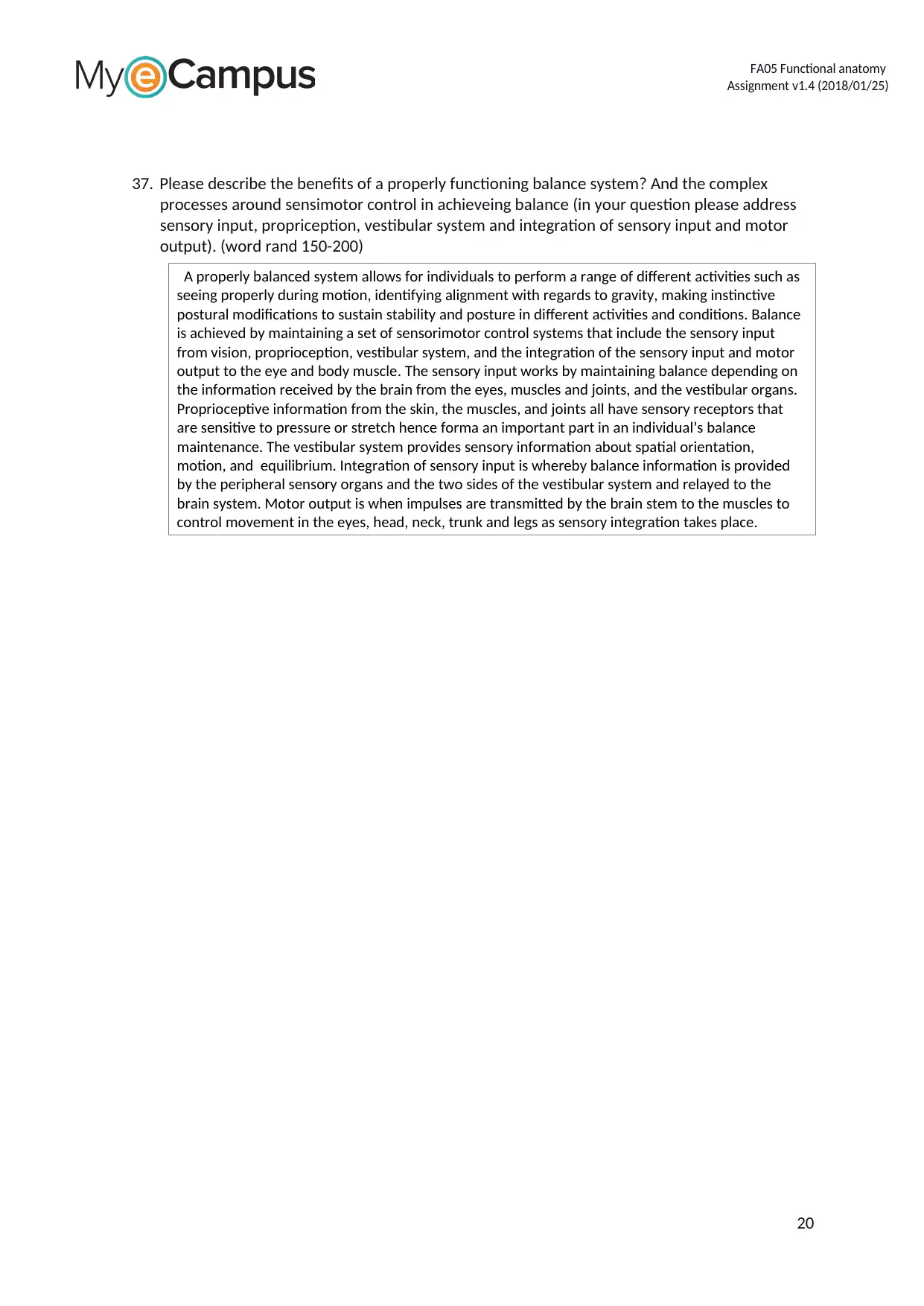
FA05 Functional anatomy
Assignment v1.4 (2018/01/25)
37. Please describe the benefits of a properly functioning balance system? And the complex
processes around sensimotor control in achieveing balance (in your question please address
sensory input, propriception, vestibular system and integration of sensory input and motor
output). (word rand 150-200)
A properly balanced system allows for individuals to perform a range of different activities such as
seeing properly during motion, identifying alignment with regards to gravity, making instinctive
postural modifications to sustain stability and posture in different activities and conditions. Balance
is achieved by maintaining a set of sensorimotor control systems that include the sensory input
from vision, proprioception, vestibular system, and the integration of the sensory input and motor
output to the eye and body muscle. The sensory input works by maintaining balance depending on
the information received by the brain from the eyes, muscles and joints, and the vestibular organs.
Proprioceptive information from the skin, the muscles, and joints all have sensory receptors that
are sensitive to pressure or stretch hence forma an important part in an individual’s balance
maintenance. The vestibular system provides sensory information about spatial orientation,
motion, and equilibrium. Integration of sensory input is whereby balance information is provided
by the peripheral sensory organs and the two sides of the vestibular system and relayed to the
brain system. Motor output is when impulses are transmitted by the brain stem to the muscles to
control movement in the eyes, head, neck, trunk and legs as sensory integration takes place.
20
Assignment v1.4 (2018/01/25)
37. Please describe the benefits of a properly functioning balance system? And the complex
processes around sensimotor control in achieveing balance (in your question please address
sensory input, propriception, vestibular system and integration of sensory input and motor
output). (word rand 150-200)
A properly balanced system allows for individuals to perform a range of different activities such as
seeing properly during motion, identifying alignment with regards to gravity, making instinctive
postural modifications to sustain stability and posture in different activities and conditions. Balance
is achieved by maintaining a set of sensorimotor control systems that include the sensory input
from vision, proprioception, vestibular system, and the integration of the sensory input and motor
output to the eye and body muscle. The sensory input works by maintaining balance depending on
the information received by the brain from the eyes, muscles and joints, and the vestibular organs.
Proprioceptive information from the skin, the muscles, and joints all have sensory receptors that
are sensitive to pressure or stretch hence forma an important part in an individual’s balance
maintenance. The vestibular system provides sensory information about spatial orientation,
motion, and equilibrium. Integration of sensory input is whereby balance information is provided
by the peripheral sensory organs and the two sides of the vestibular system and relayed to the
brain system. Motor output is when impulses are transmitted by the brain stem to the muscles to
control movement in the eyes, head, neck, trunk and legs as sensory integration takes place.
20
1 out of 20
Your All-in-One AI-Powered Toolkit for Academic Success.
+13062052269
info@desklib.com
Available 24*7 on WhatsApp / Email
![[object Object]](/_next/static/media/star-bottom.7253800d.svg)
Unlock your academic potential
© 2024 | Zucol Services PVT LTD | All rights reserved.

